

A key aspect of the development of asset management is data collection. The way in which road organizations collect, store, and analyze data has evolved along with advances in technology, such as mobile computing (e.g., handheld computers, laptops, tablet notebooks, etc.), sensing (e.g., laser and digital cameras), and spatial technologies (e.g., global positioning systems (GPS), geographic information systems (GIS), and spatially enabled management systems).
Bridges are normally only second to pavements in magnitude of network expenditures. Bridges also significantly affect the safety and performance of a roadway network. Bridge condition inadequacies can affect the traveling public as well as an agency. Bridges that deteriorate into poor condition often require more frequent maintenance and on demand repairs that cause traffic disruptions and place administrative and economic burdens on the agency. Bridge performance is also impacted by load capacity and geometric inadequacies that may cause restrictions on truck sizes and allowable weights, or may cause waterways to overtop the bridge at unacceptable frequency for the roadway classification. These factors can also affect roadway network performance as bridge inadequacies may cause traffic to take alternate routes.
Data collection is also valuable for other roadway features or asset classes when they affect safety, performance, or cost to manage the roadway network. Tunnels, slopes, retaining walls, sign structures, drainage structures, guide rails, etc. are included in this category.
The use of these systems and technologies has enhanced the data collection and integration procedures necessary to support the analyses and evaluation processes needed for asset management but at the same time has led organizations to collect very large amounts of data and create vast databases that have not always been useful or necessary for supporting decision making processes.
Asset condition data collection activities should be designed to support asset management decision processes at different levels. This should include a rational evaluation of what data should be collected to cost-effectively support the asset management decision. As asset management includes a variety and type of assets, one type of data, for example traffic, may be needed for multiple applications. Information for all asset needs should be considered when establishing the data collection program. Once the data needs are established, a data collection plan can be developed to outline the type and frequency of data collection. The plan should include procedures for quality control validation of the data. Once the data quality is confirmed, it can then be transformed into performance indices.
One of the key components of the management of assets is to inventory and document that assets that are the responsibility of an organization along with their current condition (OECD 2001). Different types of data are required for the effective management of the road infrastructure (PIARC 2004). This may include inventory information, age, remaining life and performance information (e.g. pavement smoothness, bridge structural capacity, etc.). Data collection technologies and data needs vary depending on which infrastructure element is evaluated (Birmingham 2002) and on road organization needs and culture as well as the availability of economic and human resource. Therefore, there is no one-size fits-all approach for asset management data collection.
The data collected should support the following objectives:
In today’s big data world it is possible to gather data on just about anything, but the primary objective should be to collect only data that will measure progress toward the defined goals and help road organization to make decisions.
The data needed by any road organization are those that influence (World Bank 1997):
In principle, asset management data falls into three main types and can be grouped as follows:
Inventory and condition data refer to the key infrastructure areas or the primary asset components including liner and points assets, as shown in table 2.1.2.1.
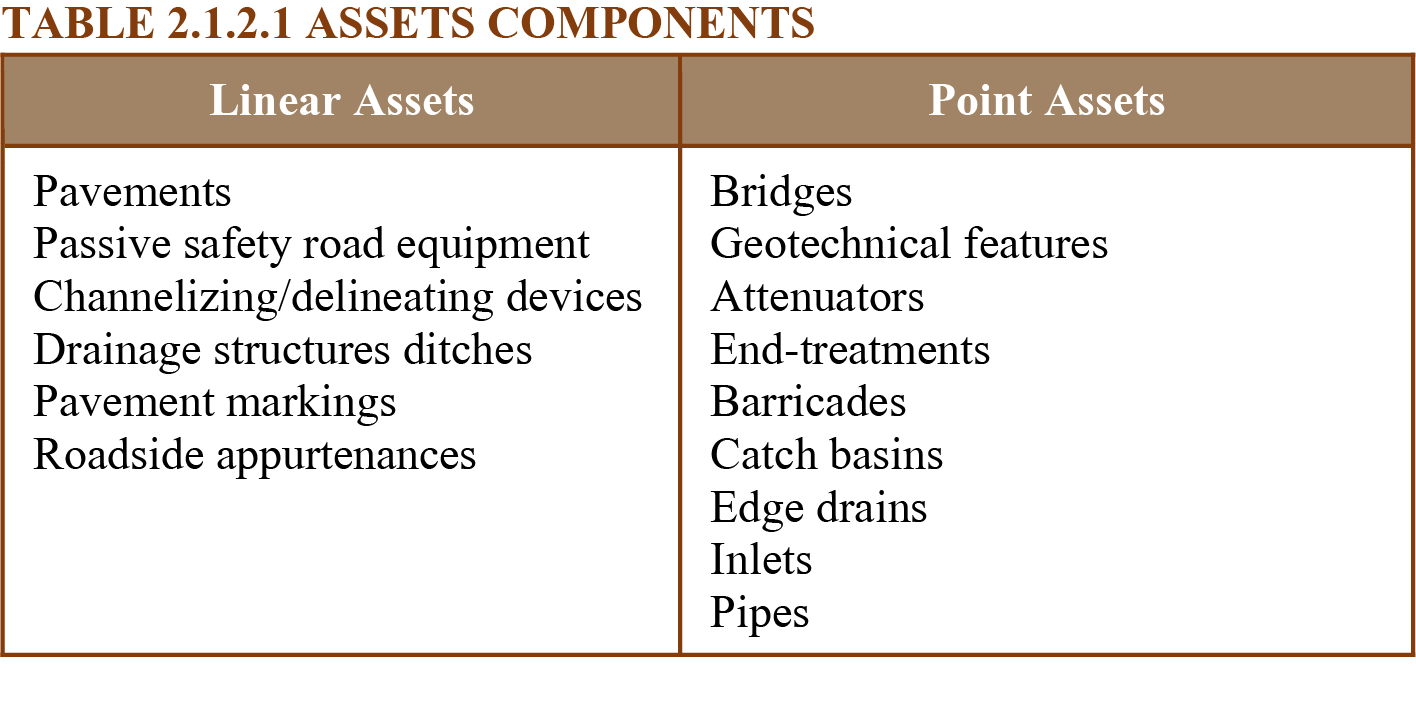
Regardless of the maturity level of a specific road organization, it is imperative that a data management strategy be defined (Telli 2010). A data management strategy may comprise the following:
The following questions should be considered when deciding what data to collect:
The data collection process begins with the establishment of data needs. Data needs will vary from agency to agency depending on the complexity of the transportation network, the level of maturity of the agency, available technology and indices used to reflect the condition of the assets (U.K. Roads 2013). For relatively small and less complex networks, this may consist of a visual survey to establish an overall condition index. Larger networks in more developed countries my include the use of digital survey vehicles and other equipment that measure asset attributes using digital imaging, laser technology and equipment that measures the in-situ strength of the asset. Regardless of the method used, quality control and assurance procedures should be established to ensure the consistency of the condition assessments. While multiple asset attributes may be measured to assist in making detailed project level maintenance and rehabilitation decisions, these attributes may be combined to provide a single measure of asset condition for network level asset management.
Road data can broadly be categorized into various data groups, as shown in Table 2.1.3.1.1.
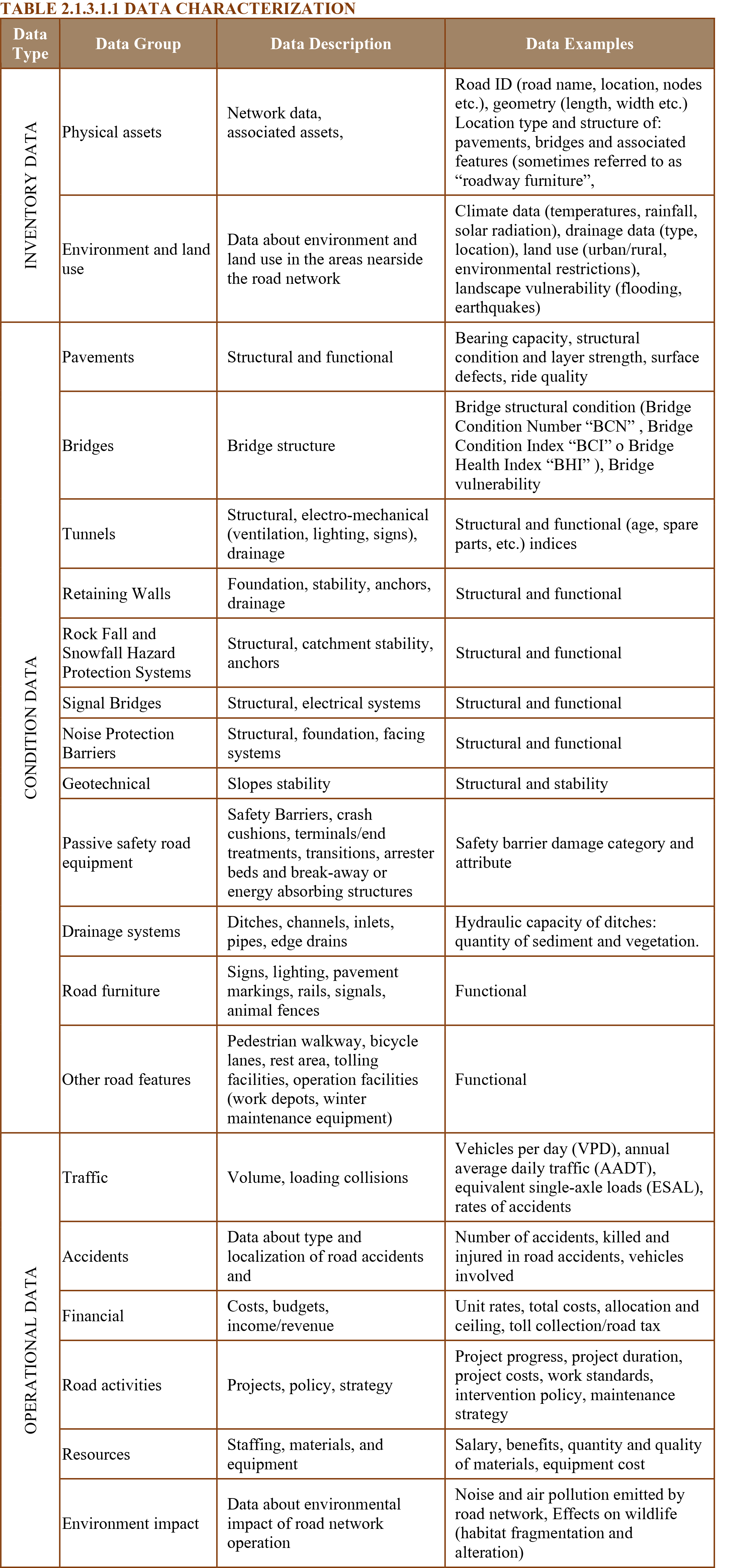
When collecting data, the road organization needs to consider the level of analysis for which it will be used, as summarized in Table 2.1.3.1.2.
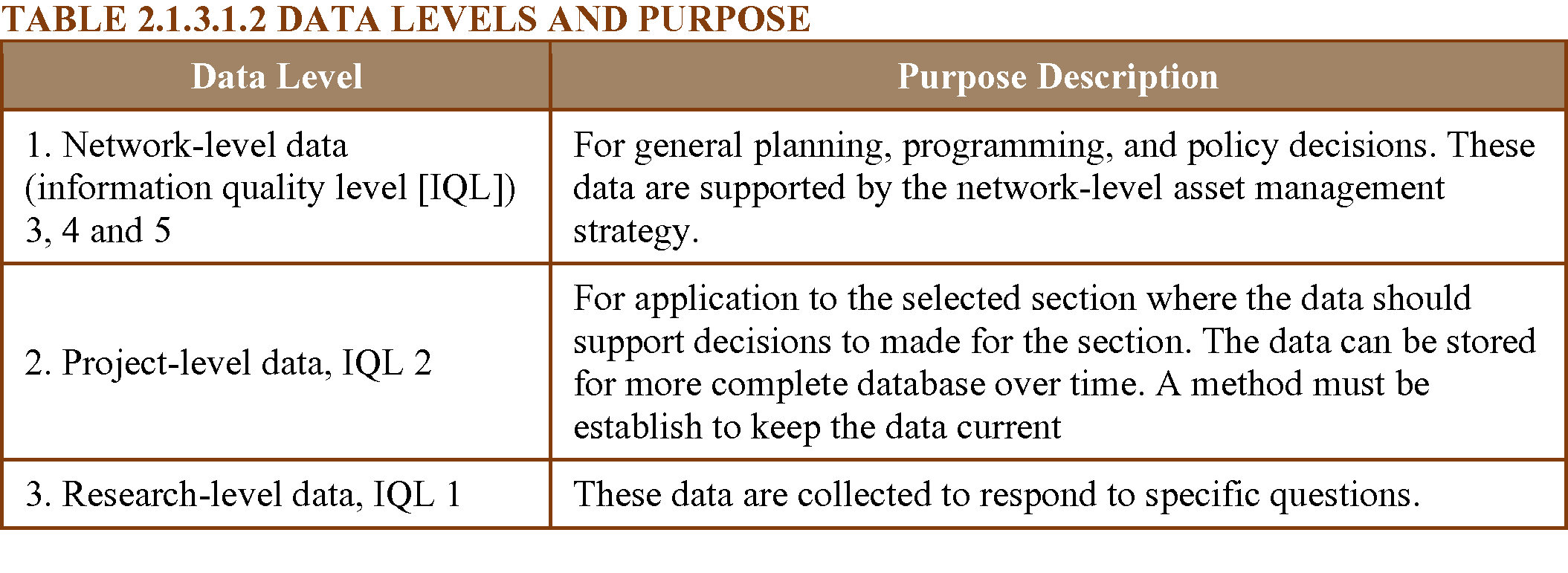
The amount of data to be collected and the frequency at which data will be collected will depend on the following:
The road data collected should be programmed or strategized to match their function in the asset management process and the data IQL. A data collection program that can be adapted by other transportation agencies is shown in Table 2.1.3.1.3.
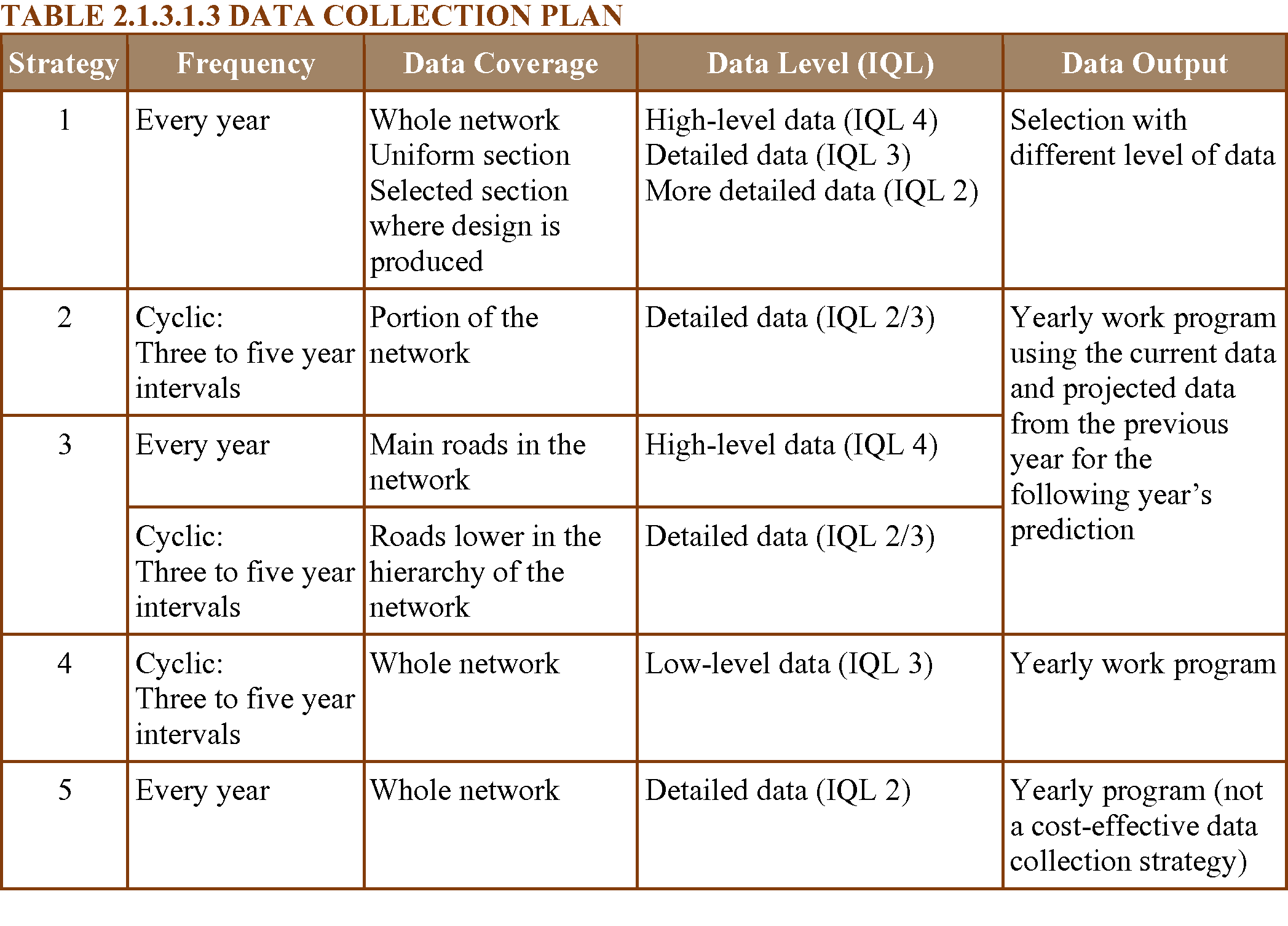
Traditional methods used for the collection of Asset Management data include manual, automated, semi-automated, and remote collection. For manual collection the data are documented either with pen and paper, or in more recent cases, with handheld computers equipped with GPS. Automated collection involves the use of road sensors or multipurpose vehicle equipped with a position/navigation system (e.g. distance-measuring device and GPS antennas), a combinations of different sensing technologies (e.g. video cameras, gyroscopes, laser sensors, etc.) as well as computer hardware in order to capture, store, and process the collected data. Semi-automated methods involve similar equipment as the completely automated method but with a lesser degree of automation. Remote Collection method pertains to the use of satellite imagery and remote sensing applications (e.g. high-resolution images acquired through satellites, aerial photos, etc.).
In the last decades, data collection have shown a trend toward automation, computerization and digitalization. Furthermore, there is a great expectation of taking the advantage of big data (e.g. data collected by users by smartphone) in the asset management process.
The following factors determine the selection of technologies and equipment for data collection:
It will be advantageous if the equipment or methods employed in data collection can collect road data in a single operation so that the collection will be cost-effective and consistent in referencing. The equipment for data collection can be divided into two main categories:
Various other types of technology for data collection are widely available, e.g., drones to inspect bridges, surface profilers, Falling Weight Deflectometers (FWD) for measuring the structural capacity of the pavement and to back-calculate pavement and subgrade layer properties, or continuous deflection measurement systems such as the Rolling Wheel Deflectometer (RWD), RWDVision and Travelling Speed Deflectometer (TSD), equipment to measure paint marking condition and retroreflectivity, rolling resistance, pavement surface friction, light detection and ranging (LiDAR) to map roadside equipment and features, ground penetrating radar (GPR) to determine pavement layer thicknesses and bridge surface condition and rolling resistance equipment. PIARC has recently completed a special report (PIARC 2018) on the use of unmanned aerial systems use for asset condition inspection and data collection.
Figures 2.1.3.2.1 through 2.1.3.2.9 show some examples of data collection equipment and systems.
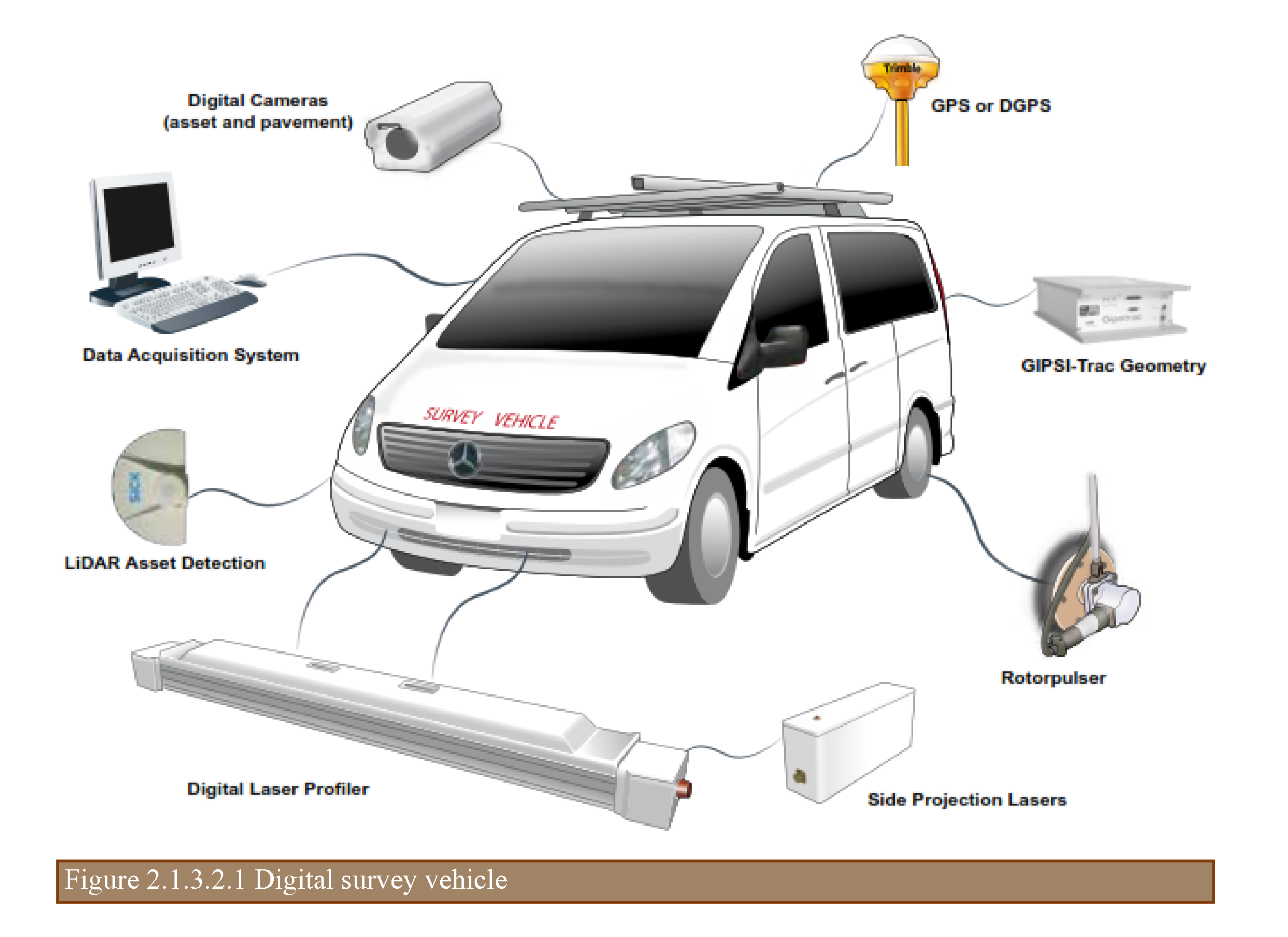
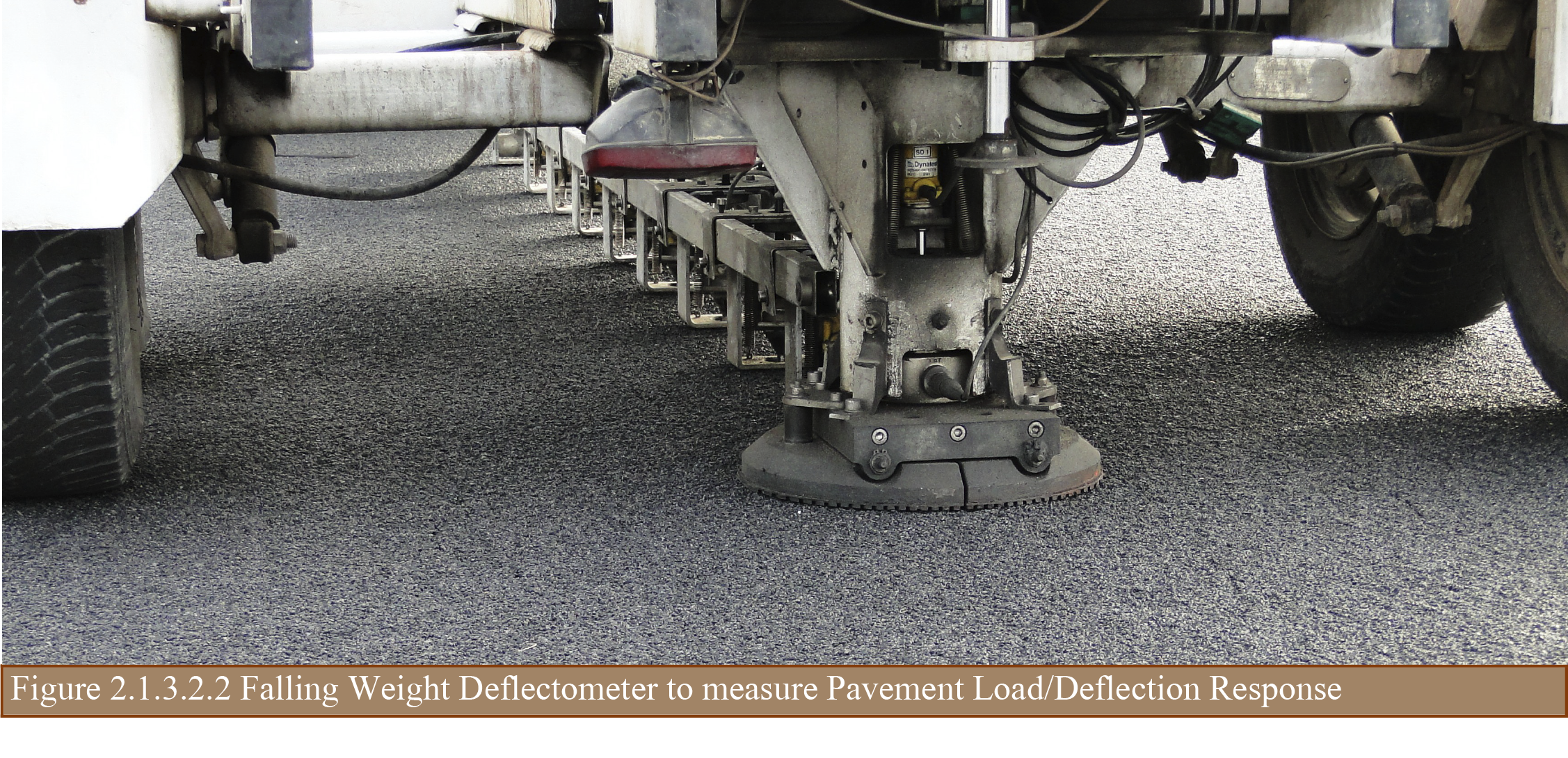
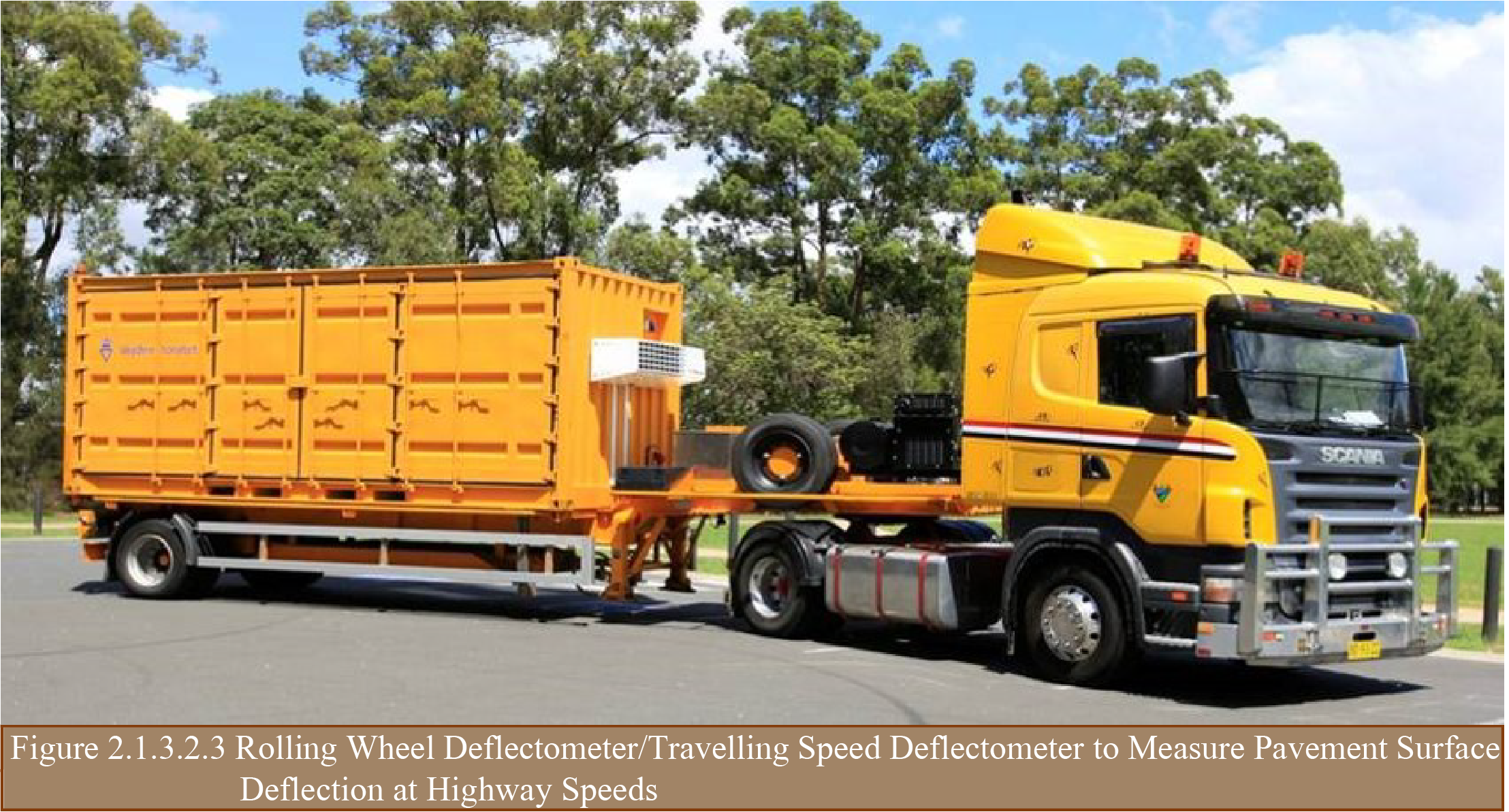
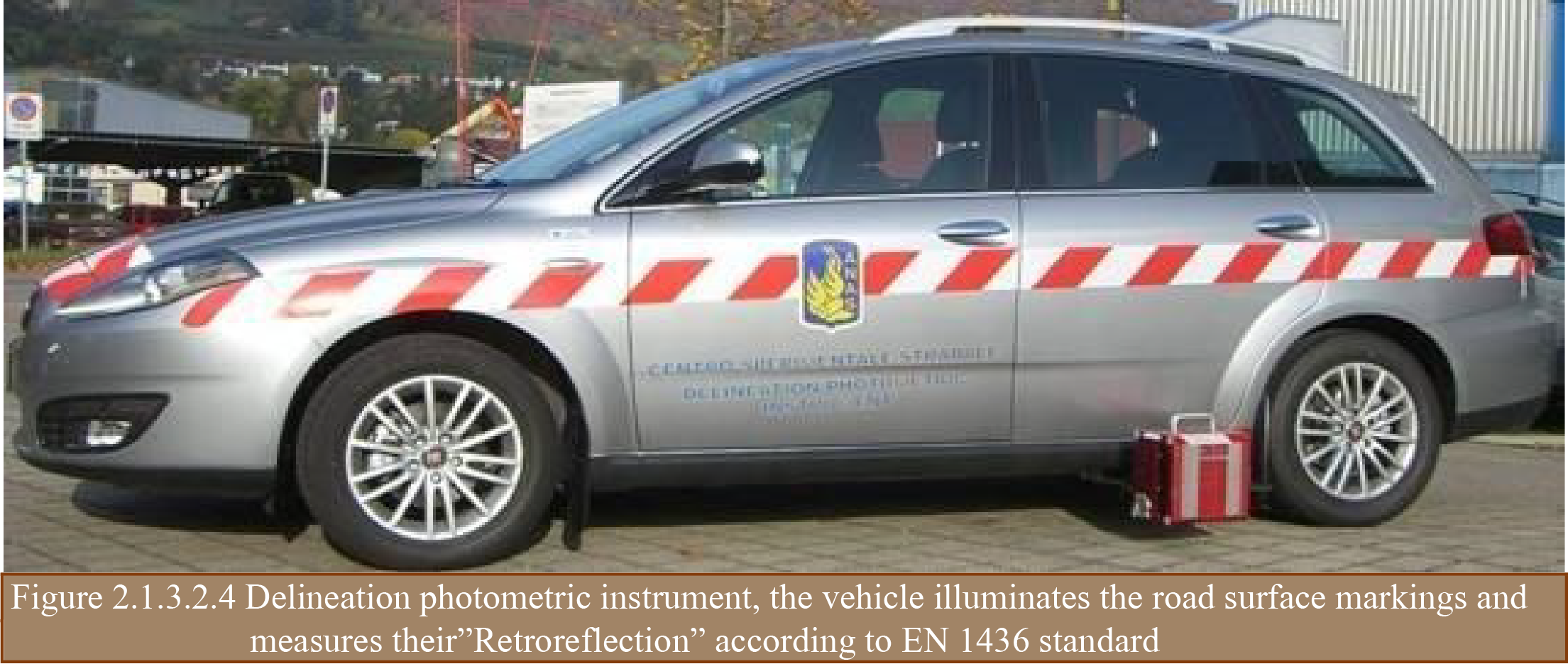
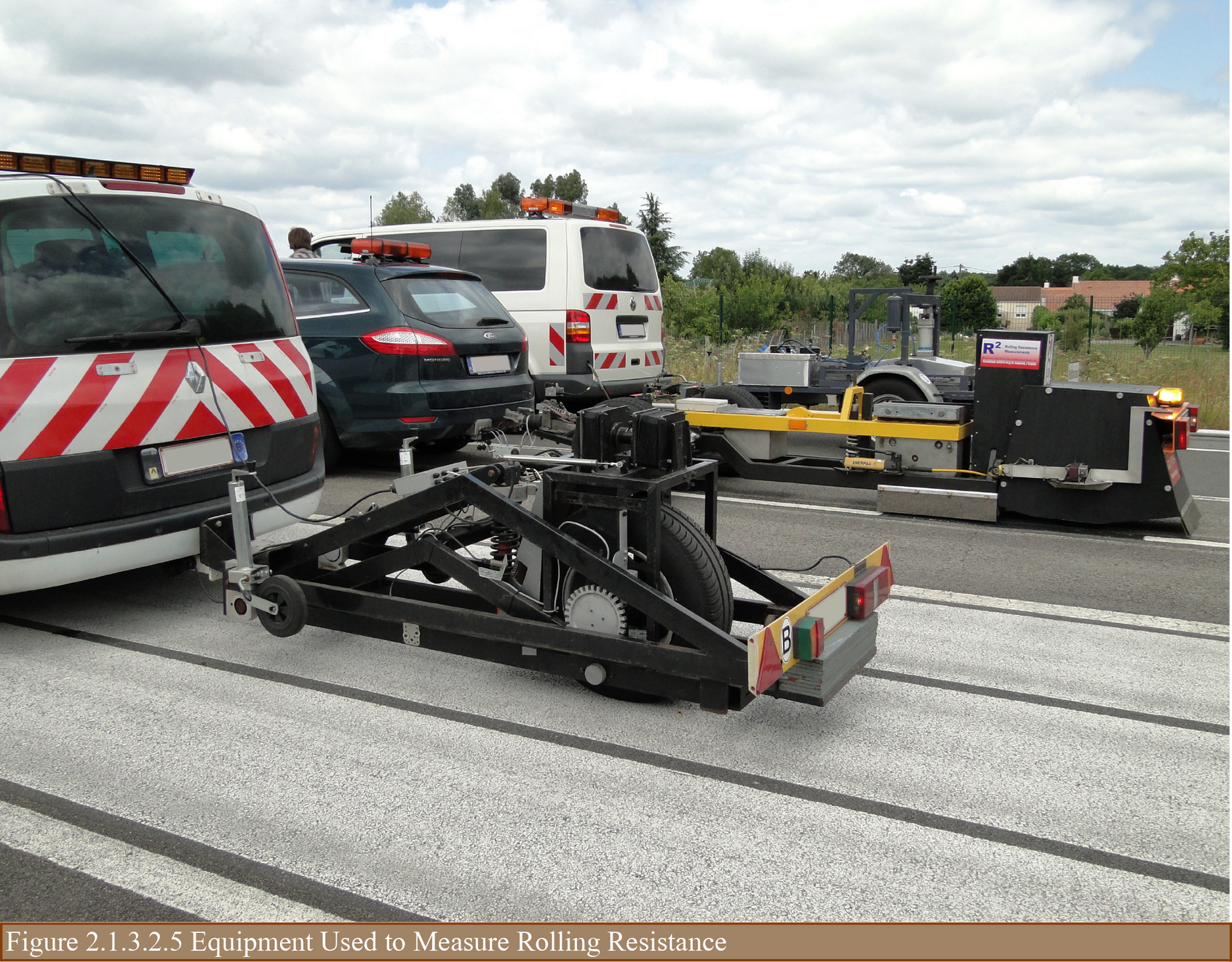
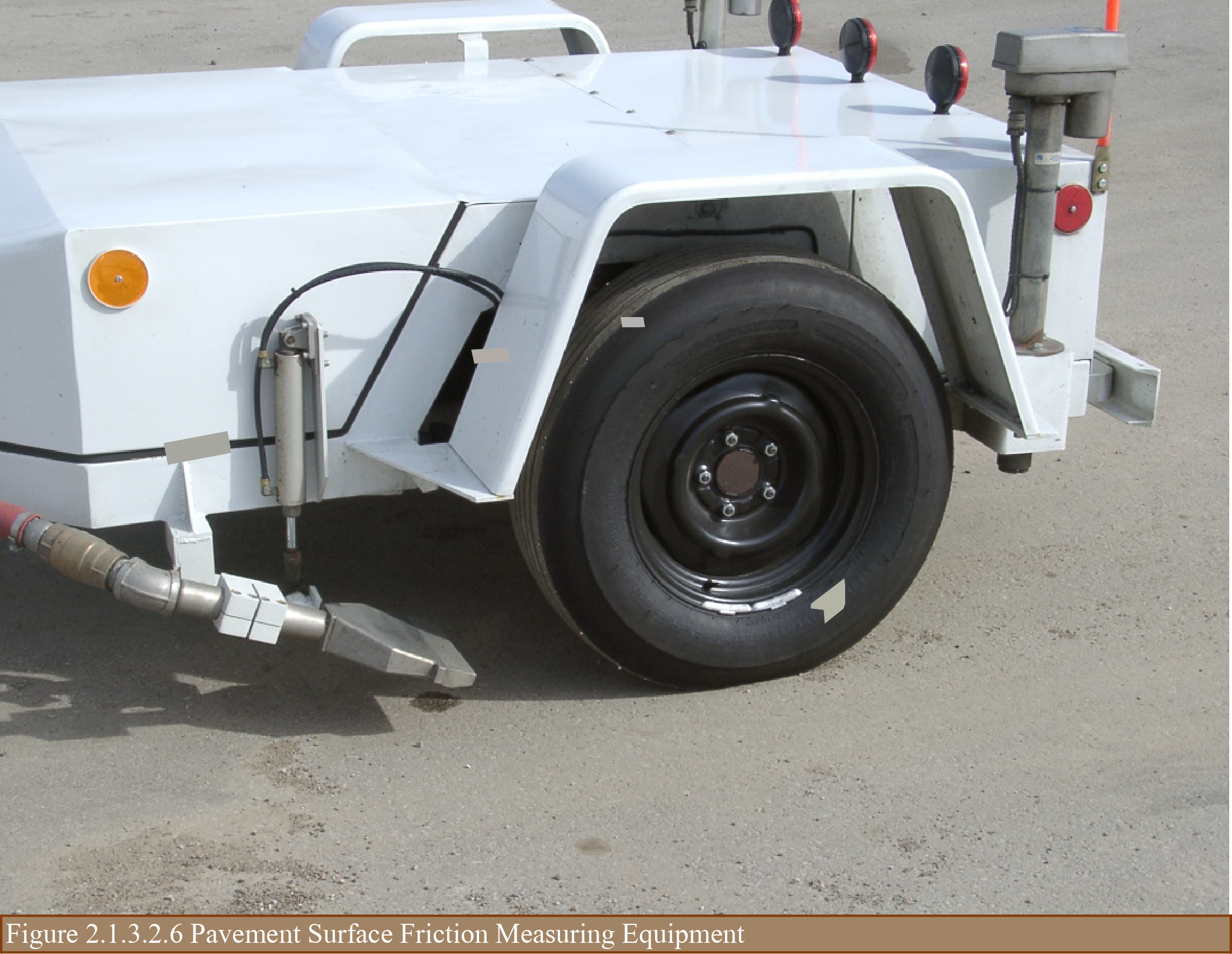
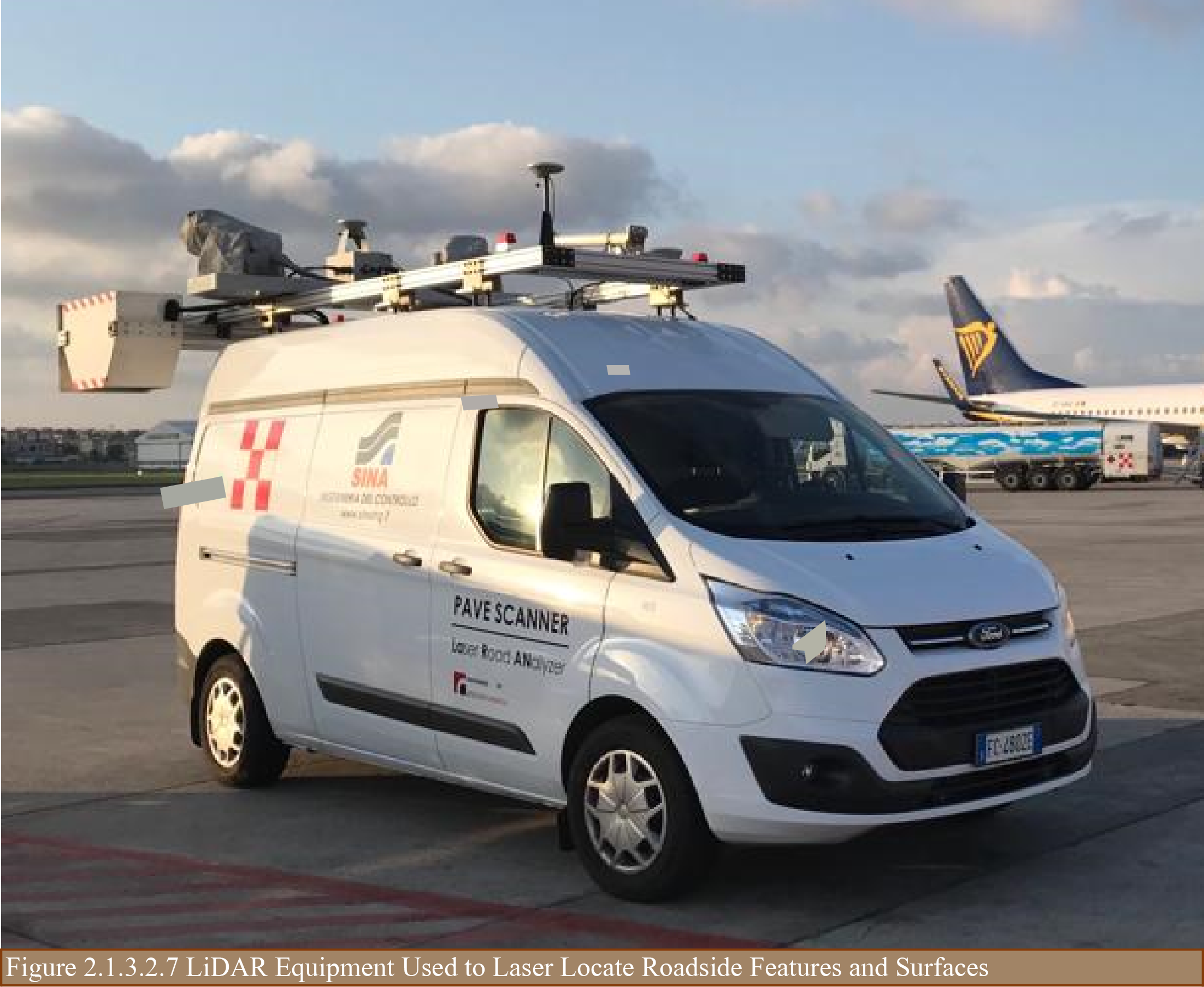
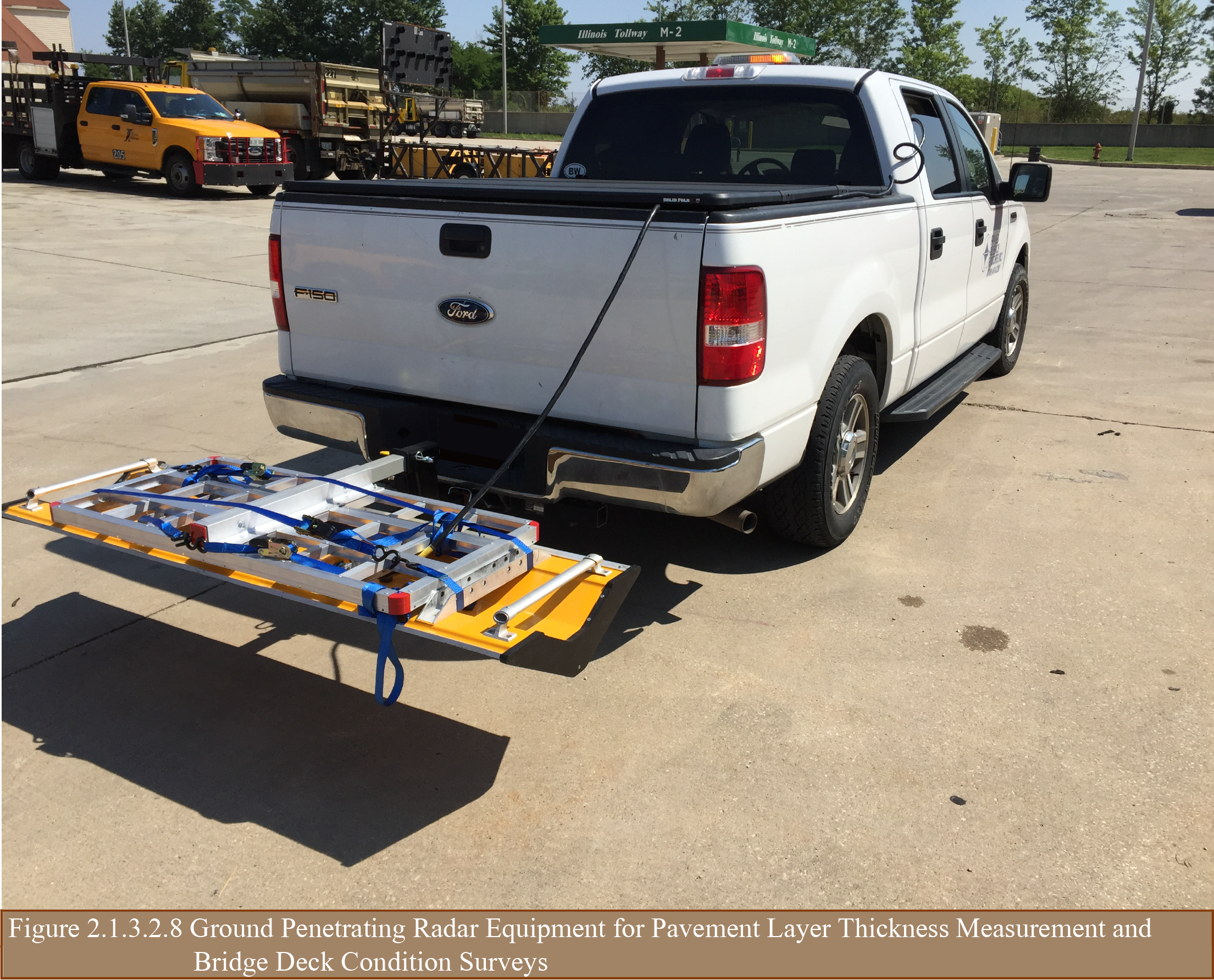
Recent additions to digital survey vehicles include the use of laser crack measurement systems (LCMS). The LCMS is a high-speed 3D laser scanning system that scans a pavement width of 4 m using 4,000 points, and provides a transverse accuracy of 1 mm and a vertical accuracy of 0.5 mm. e frequency is operator-configurable between 5,600 or 11,200 Hz. The resulting resolution and accuracy is 5 to 10 times that which is available from typical mobile LiDAR systems.
Additionally, the LCMS is capable of a fully automatic inspection of the pavement condition, and can measure the following key parameters:
An example of the LCMS crack detection output for an asphalt pavement surface is shown in Figure 2.1.3.2.9.
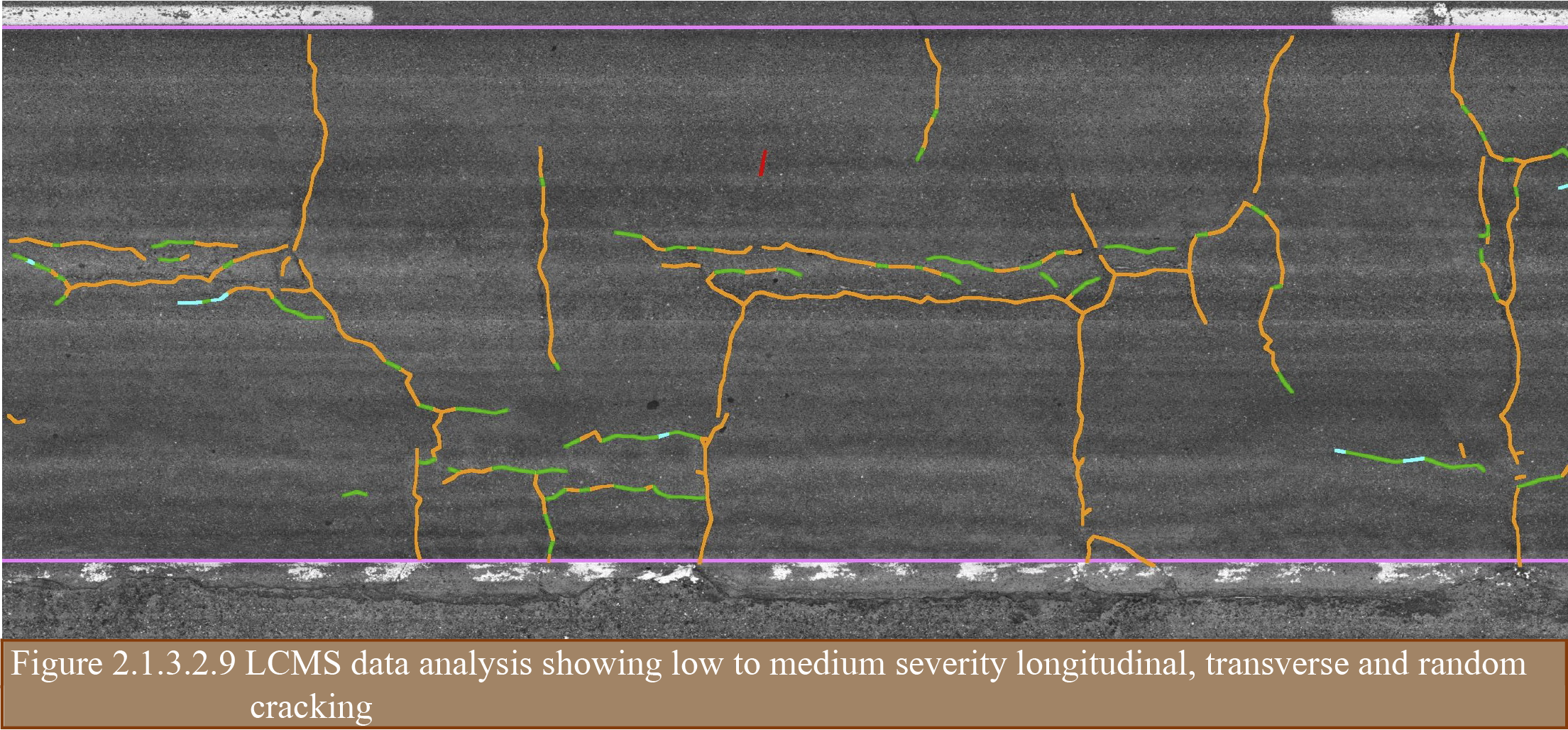
Bridges are different from other asset classes because they have many features, all of which significantly impact safety, performance, and management costs. Therefore, bridge data is often extensive and complex. The data that supports assessment of safety, performance, and cost include bridge condition data and bridge inventory data such as bridge type and material, service and usage, geometry, load capacity, and potential work needs and costs. Bridge inventory and condition data is collected to support management of individual bridges as well as management of the roadway network.
With respect to condition data, there are different systems of inspection and data collection. One system can be termed general condition rating assessment. Following this system, the major components of a bridge are each independently assessed for condition. Major components include the deck, superstructure, and substructure. Each component is assigned a single numeric value representative of the overall condition of the component. An example of a general condition rating numeric scale is shown in Table 2.1.3.1.4.
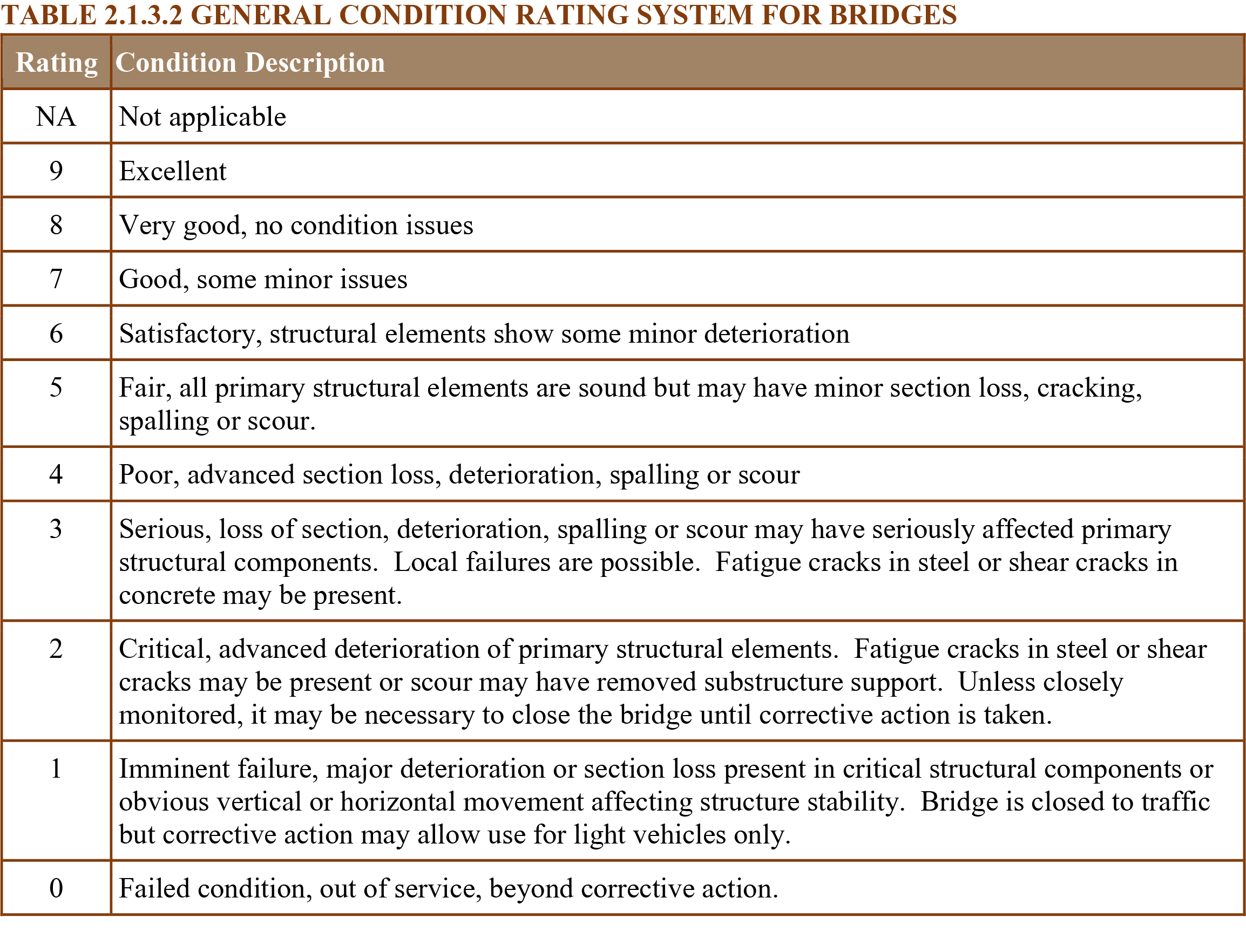
Bridge owners use the general condition ratings to assess the overall condition of bridges and support basic bridge management activities such as identifying high level bridge needs, establishing performance measures, and establishing intervals between inspections.
Another system of condition inspection and data collection is termed element condition assessment. This system subdivides the components into elements that are more granular than components, and it quantifies the type, severity, and extent of defects that are present. First, the unique elements of a bridge for which condition data can be collected are identified. Then the amount of each element is quantified with respect to its size (area or length) or number of elements. During each inspection, the condition of each element is evaluated and the total quantity is distributed among several condition states depending on the type and severity of defects. The use of four condition states is common where condition state number one represents a like-new condition and condition state number four represents a severe condition that warrants structural review, repair, or replacement. This system is also valuable because it identifies the condition of features that are vital to protecting the bridge and preventing deterioration such as protective deck overlays, deck joints, coatings, and erosion protection. The condition of these elements significantly affect bridge service life and life-cycle cost to manage bridges. Bridge owners can use the element condition data for advanced bridge management activities such as accurate identification of bridge maintenance, preservation, and repair needs and associated costs, detailed performance measures that focus on specific bridge features (for example protective systems that extend service life), and asset valuation computations.
Condition data for bridges is normally collected by visual means supplemented by simple hand held devices including sounding tools (hammers) to determine material integrity, dimensional measurement tools (rulers, calipers, etc.) to determine corroded steel remaining thickness, crack dimensions, displacements, etc., and waterway probing sticks to determine integrity of soil foundation material. Advanced tools may be used to investigate known problems and vulnerabilities, or to provide more accurate assessment of phenomenon and deficiencies that are difficult to detect visually. For example, bridge decks are normally difficult to assess without interrupting traffic, and are commonly composed of reinforced concrete, a material type whose defects may not be detected by visual means. Some owners are using vehicle mounted infrared thermography or ground penetrating radar to assess bridge deck condition. This data collection can proceed at normal roadway travel speeds and produce sufficient data to identify early prevention treatment needs, determine the most cost effective work action for decks (preservation, rehabilitation, or replacement), or assist in future planning and budgeting.
Infrared thermography assessment measures temperature variations across the surface of an object. Radiated temperature variations result from differences in thermal conductivity, specific heat capacity, and mass density (Figure 2.1.3.2.10). When solar radiation heats up a bridge deck, the absorbed energy is gradually emitted. Delamination, voids, and other anomalies have different properties than the surrounding concrete and will emit different radiation. Infrared thermography performs well identifying locations of horizontal cracking or voids. The two predominant modes of bridge deck deterioration result in horizontal cracking or planar voids. Corrosion of multiple and adjacent bridge deck reinforcing steel bars results in delamination which is horizontal planar cracking induced by steel volume increase from corrosion. Bridge deck rigid overlay deterioration often starts as debonding from the deck substrate which appears as horizontal voids. Infrared thermography surveys are conducted using infrared cameras in combination with conventional video imaging. A manual review of the images is then performed to estimate location, magnitude, and severity of deterioration which shows up as locations of greater emittance.

Assessment by ground penetrating radar involves transmitting electromagnetic waves and measuring the reflections (Figure 2.1.3.2.11). The amplitude, frequency, and properties of the reflected waves are dependent on the material properties. A portion of the energy is reflected from material differences, interfaces, and discontinuities. The deck surface, reinforcing steel surface, and large voids are the predominant reflectors. Ground penetrating radar does not perform as well as infrared thermography at identifying deck delamination and overlay debonding, but it performs well mapping reinforcing steel depth and assessing the potential for concrete deterioration and delamination. The attenuation of the signal at the level of reinforcing steel is normally used to represent the condition of the deck. When an antenna is centered directly above the steel, the highest amplitude return is obtained. This amplitude will be highest when the location is in good condition and lowest when corrosion and delamination is present. The technology requires specialized expertise for data collection and post processing for correct interpretation of results. Similar to infrared thermography, the data can be used to estimate location, magnitude, and severity of deterioration.
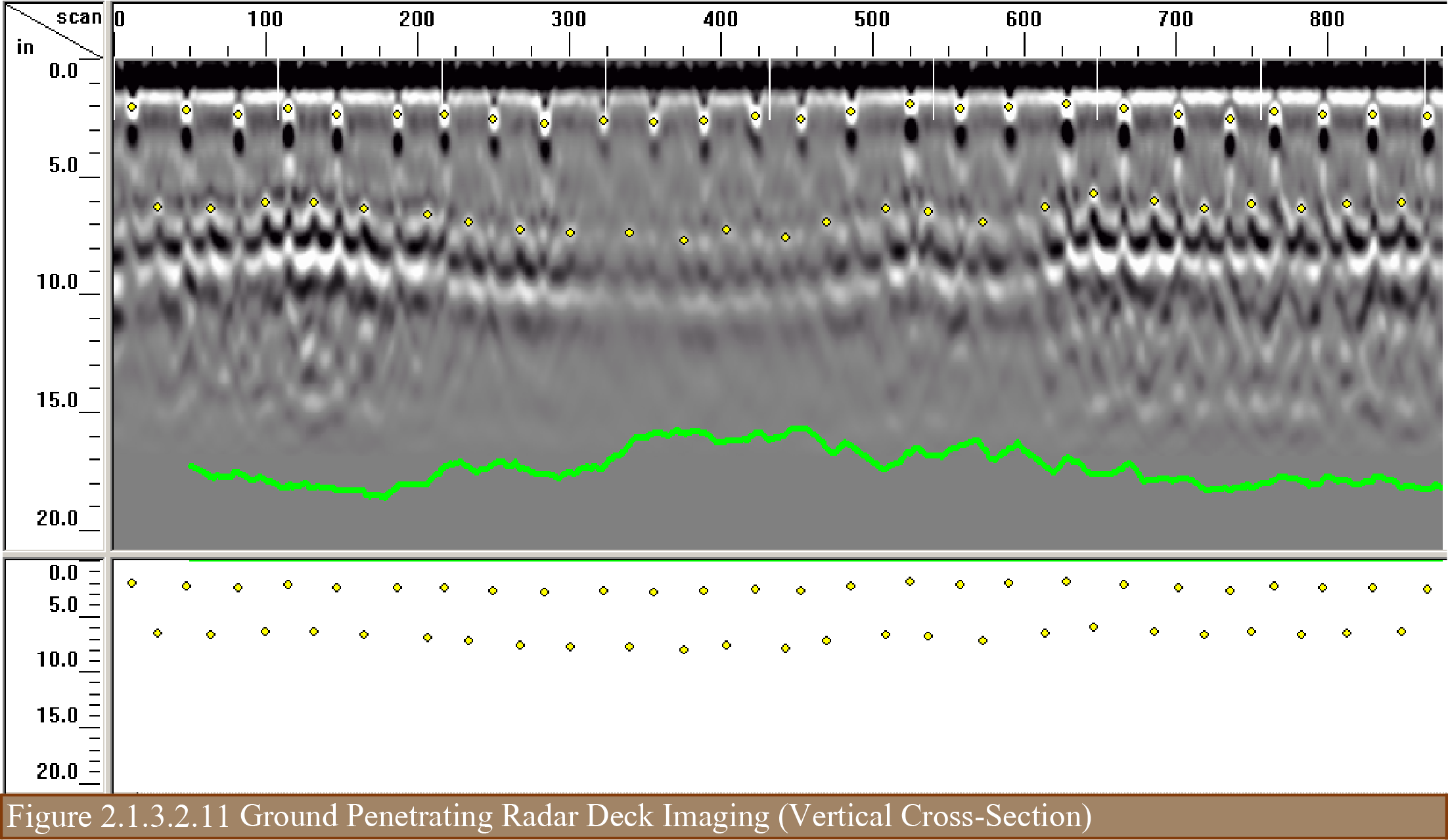
It is important to ensure the quality of data during its collection. Quality control and assurance is important during all stages and processes including pre-survey calibration, during the survey, validation, daily checks, continuous monitoring of equipment and results, correct processing, and the storing and securing of data.
A detailed quality management plan (QMP) should be prepared for the data collection. The QMP is expected to ensure that the acquisition of the required data meets the road organization’s needs and specifications. The QMP has to address, among other considerations, the following issues:
Condition indices describe a set of discrete, ordered states determining the rating of asset condition parameters. Trained condition rating personnel may assess the current state of the asset and assign a rating to that asset. However, the subjective rating can vary by rater.
The pavement conditions normally evaluated for asset management are as follows:
The above characteristics are measured in the field by acceptable equipment and methodologies and are quantified by means of indicators or condition indices. Typical pavement condition indicators and indices are shown in Table 2.1.3.4.
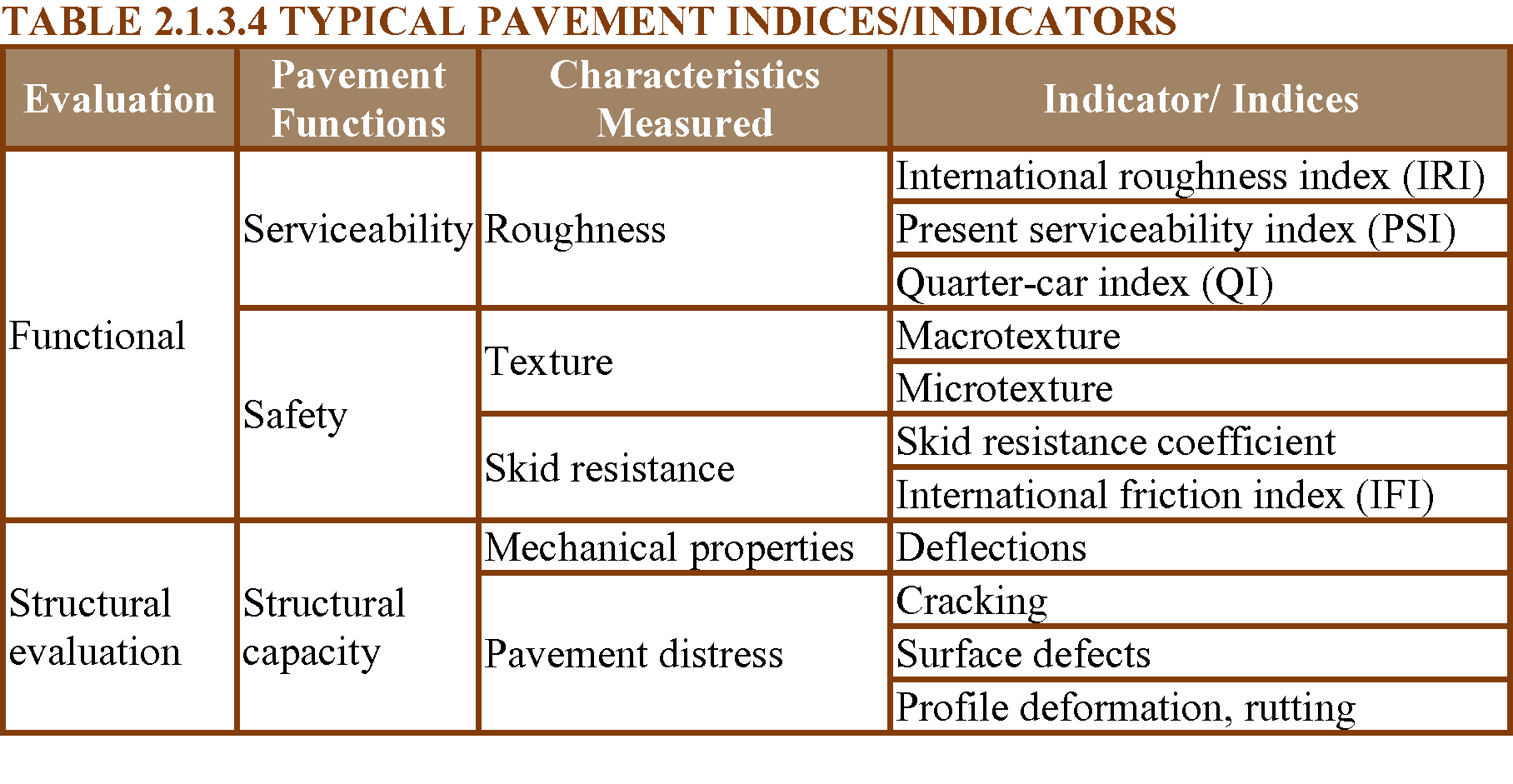
Bridge condition indices are typically represented by condition states of individual elements that are then combined in to component rating, e.g. deck rating and then an overall bridge condition index (BCI).
Bennett 1999. Bennett, C.R. and Paterson, W.D.O. Guidelines on Calibration and Adaptation, HDM-4 Technical Reference Series, Volume 5.
Bennett 2007. Bennett, C.R. et al. Technologies for Road Management, Version 2, The World Bank.
Birmingham 2002. University of Birmingham/Transit NZ. Road Asset Management Principles.
Flintsch, G. W., & Bryant, J. W. (2006). Asset management data collection for supporting decision processes. US Department of Transport, Federal Highway Administration, Washington, DC. (https://www.fhwa.dot.gov/asset/dataintegration/if08018/assetmgmt_web.pdf).
OECD 2001. Asset Management for Road Sector.
PIARC 2003. Automated Pavement Cracking Assessment Equipment - State of the Art, Committee on Road Pavements, ISBN: 2-84060-156-7 (https://www.piarc.org/en/order-library/4407-en-Automated%20Pavement%20Cracking%20Assessment%20Equipment%20-%20State%20of%20the%20Art.htm)
PIARC 2004. Asset Management in relation to Bridge Management, Committee on Bridges and Other Structures (11), ISBN: 2-84060-167-2 (https://www.piarc.org/en/order-library/4414-en-Asset%20Management%20in%20relation%20to%20Bridge%20Management.htm).
PIARC 2005. Asset Management for Roads - An Overview, Committee on Road Management (C6) (https://www.piarc.org/ressources/publications/2/4545,06-09-VCD.pdf).
PIARC 2006. Asset management of Honshu-Shikoku bridges (https://www.piarc.org/ressources/publications/8/24326,Ponts-Routiers-Revue-Routes-Roads-Magazine-369-Road-Bridges-World-Road-Association-Mondiale-de-la-Route-064.pdf).
PIARC 2011. Large Road Bridges: Management, Assessment, Inspection, Innovative Maintenance Techniques, Technical Committee D.3 – Road Bridges. ISBN: 2-84060-239-3. (https://www.piarc.org/ressources/publications/6/11606,2011R06.pdf).
PIARC 2018. The Use of Unmanned Aerial Systems for Road Infrastructure, 2018SP03EN. (https://www.piarc.org/ressources/publications/10/29479,2018SP03EN.pdf).
Telli 2010. Telli Van der Lel et al. Evaluating Asset Management Maturity in the Netherlands.
UK Roads 2013. UK Roads Liason Group. Highway Infrastructure Asset Management.
USDOT 2018. U.S. Department of Transportation, Federal Highway Administration Nondestructive Evaluation Web Manual (https://fhwaapps.fhwa.dot.gov/ndep/TechnologyMenu.aspx).
World Bank 1997. Selecting Road Management Systems (http://documents.worldbank.org/curated/en/196321468762908116/pdf/multi-page.pdf).
The following case studies are presented in this chapter:
CASE STUDY 1: Implementation of Road Asset Management and Inventory Systems for the state roads of Pahang, Malaysia – Data collection
CASE STUDY 2: Road inventory and automatic visual inspection in Chile
CASE STUDY 3: Inventory, inspection and reporting of dynamic traffic management sign gantries at Flemish Roads and Traffic Agency (AWV)
The state government of Pahang, Malaysia, decided to implement a road asset management system for its state road network as part of a long-term road maintenance contract of seven years with a private company appointed in April 2013. The company was to maintain 2,300 km of the state road network and implement a road asset management system. The scope of road maintenance work included routine maintenance, periodic maintenance, and emergency maintenance. The contract also included the provision of an asset management system (YP-RAMS) and a road asset inventory management system (YP-RIMS).
The data collection for the asset management system involved the collection of road asset inventory data and a pavement condition survey to be carried out for the entire network in the first year. The collection of road asset inventory data and a pavement condition survey for 30 percent of the network was to be carried out from the second year until the end of the contract period. The use of GPS coordinates and digital recording for all asset points and referencing was compulsory. The road asset inventory management system needed to be updated and inventory reports produced every year. The new road asset management module needed to be inter-phased or integrated into a pavement management system, geographic information system (GIS), road asset inventory management system, and road inventory and road condition database.
The asset management software system makes use of a common inventory and database on the ArcGIS platform. The network condition data are measured in accordance with the International Roughness Index (IRI), cracks, and pavement strength. Digital recordings of the -of-way were taken for the entire network. Traffic data were collected from selected traffic count stations in terms of AADT and axle loading.
The project managers opted to outsource the data collection equipment rather than purchase new equipment. This proved to be cost-effective, considering the idle time between data collection intervals. The techniques and equipment used included a multi-laser profiler and automatic crack detection (ACD) system, FWD, asphalt coring, and a dynamic cone penetrometer. The techniques and equipment used are shown in Figures 2.1.5.1 and 2.1.5.2 The following data were collected:
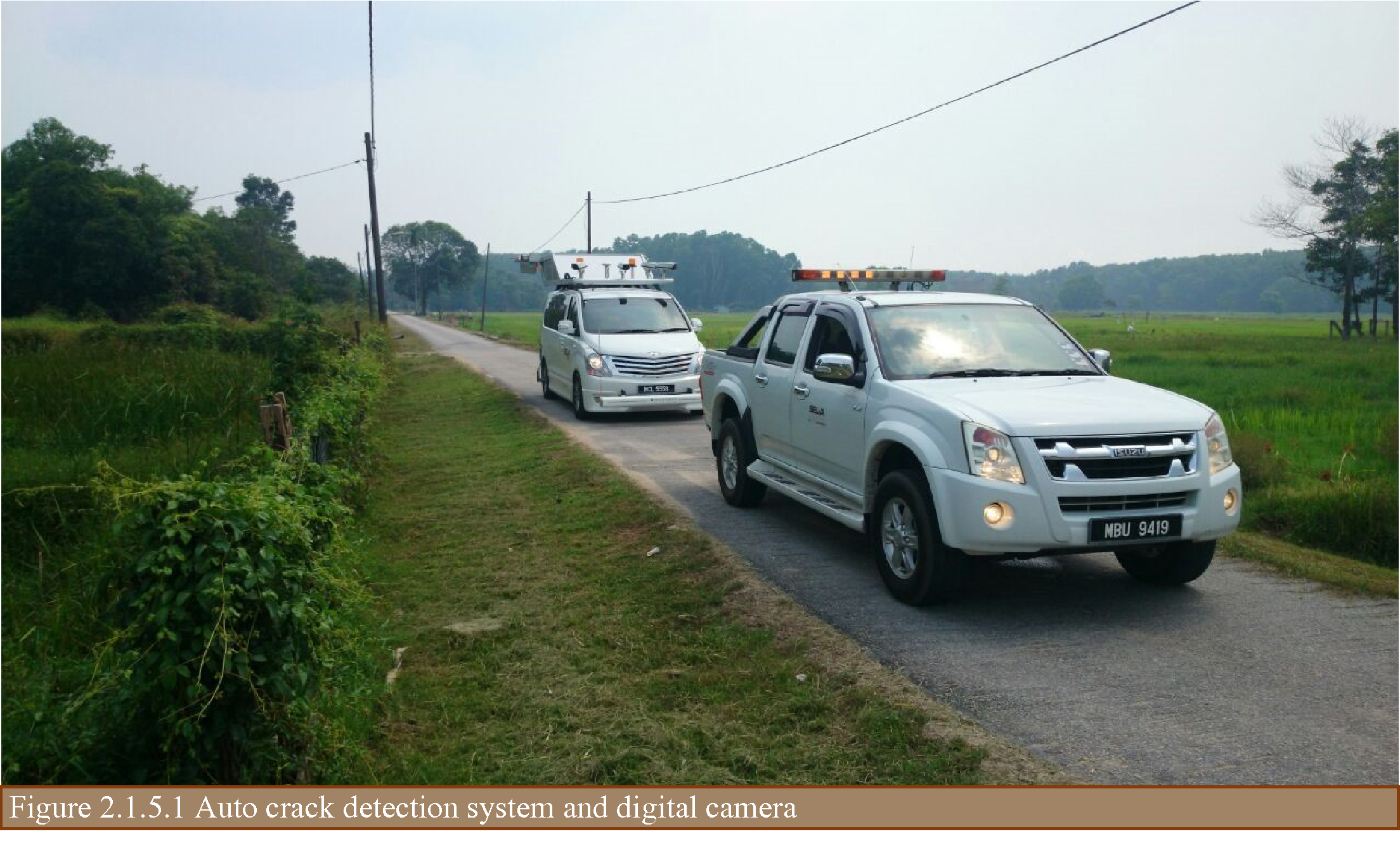
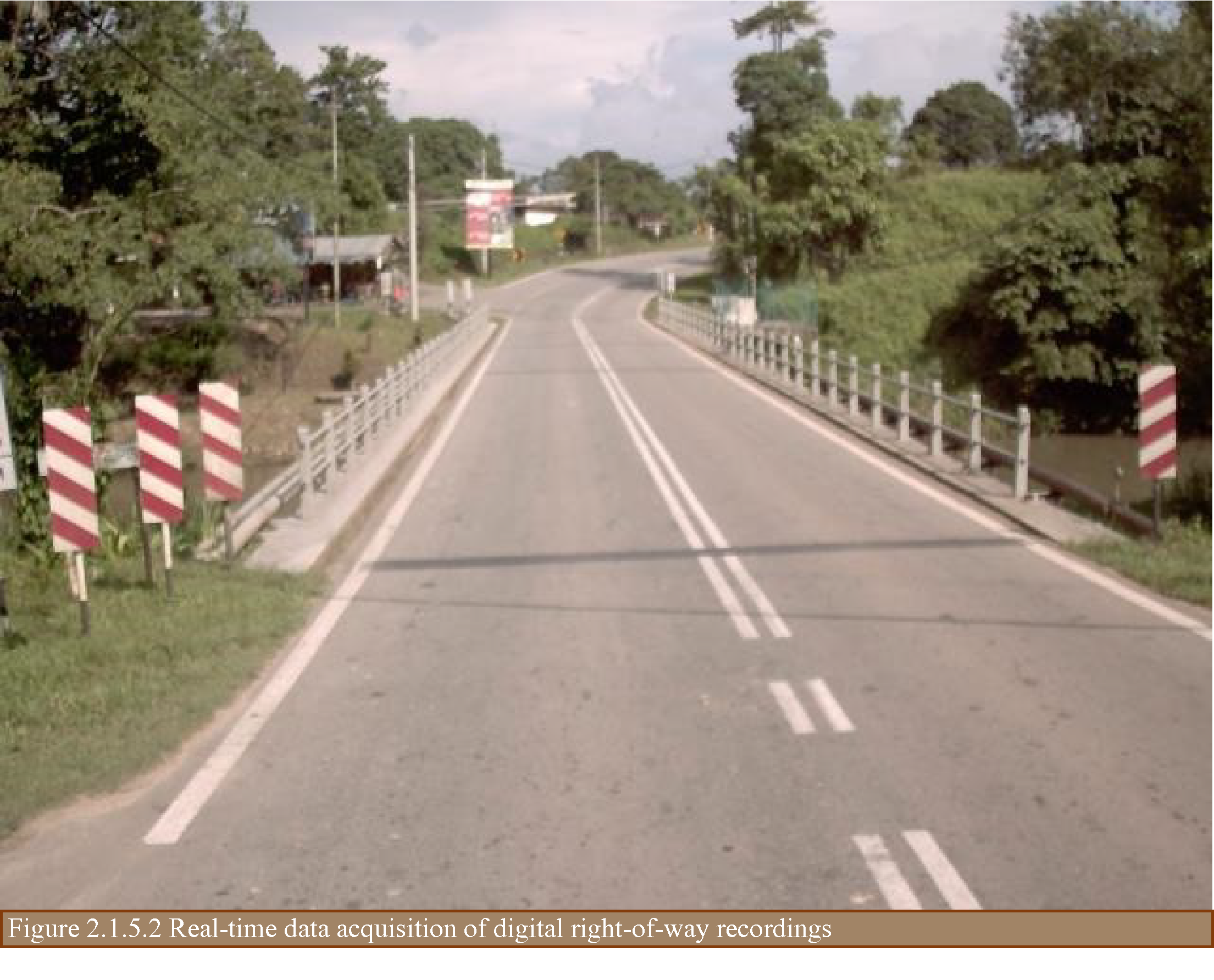
The criteria used for data collection and analysis are shown in Tables 2.1.5.1 to 2.1.5.3.
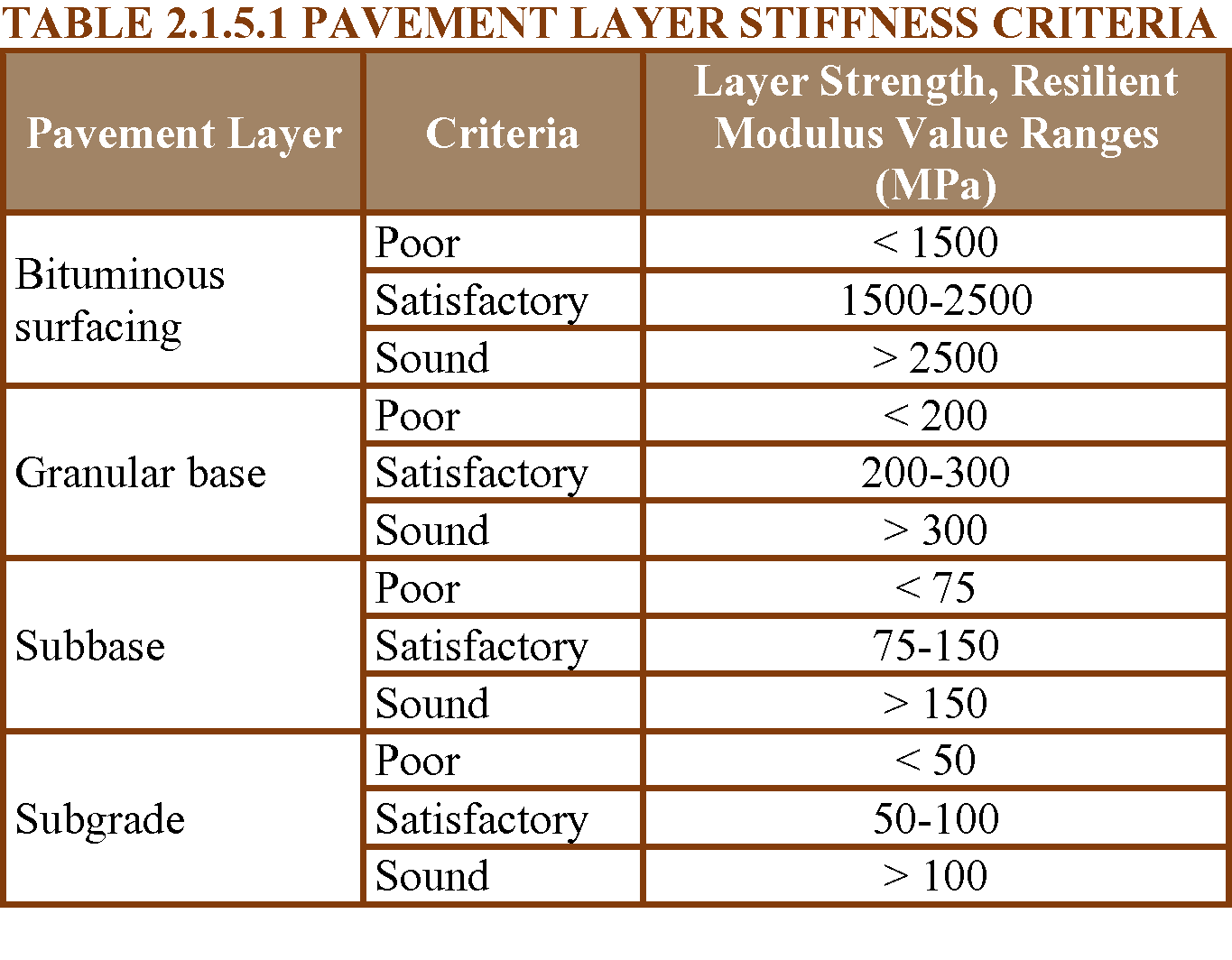
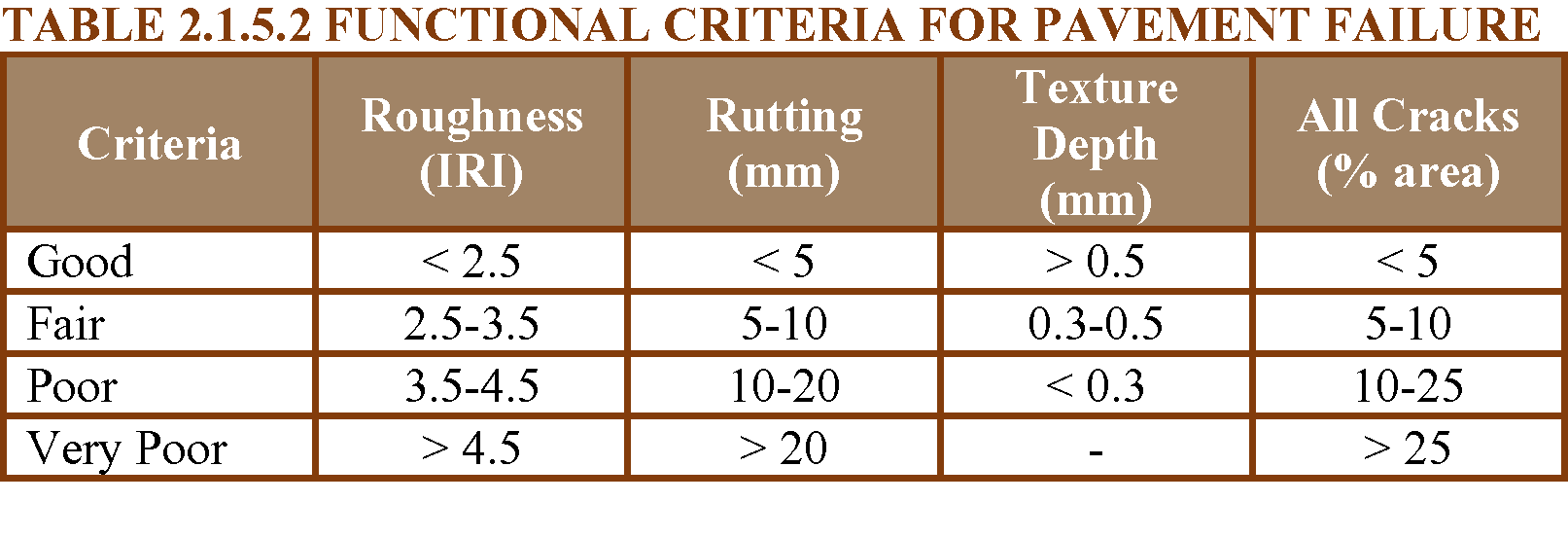

The collected road data were processed using the respective software of the equipment used. A summary of the outcome of the surveys is shown in Table 2.1.5.4.
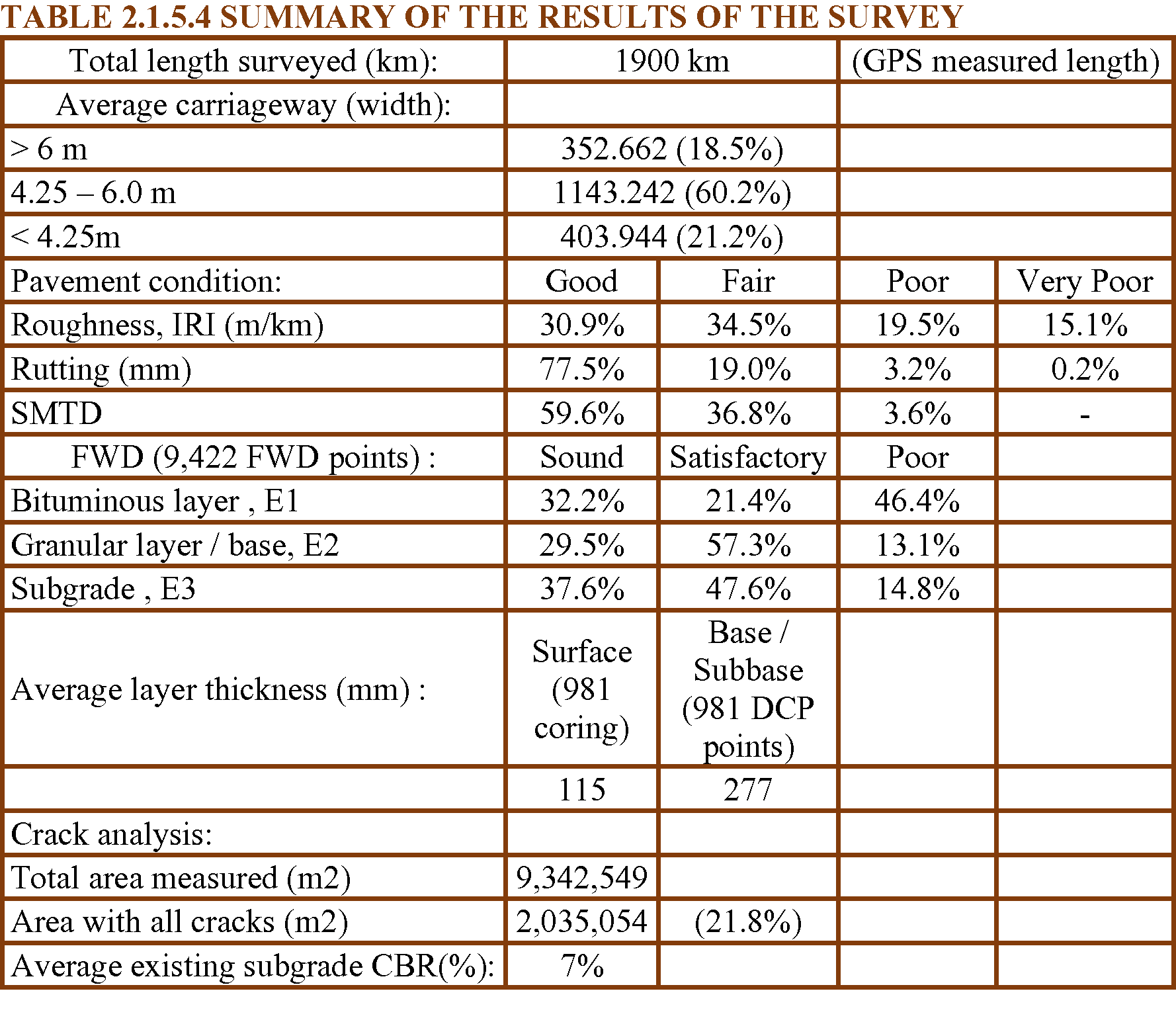
HDM-4 (Bennett 1999, 2007) was used to evaluate the maintenance requirements based on the maintenance standard specified. With the base year 2014, the predicted cost by each district is shown in Figure 2.1.5.3.
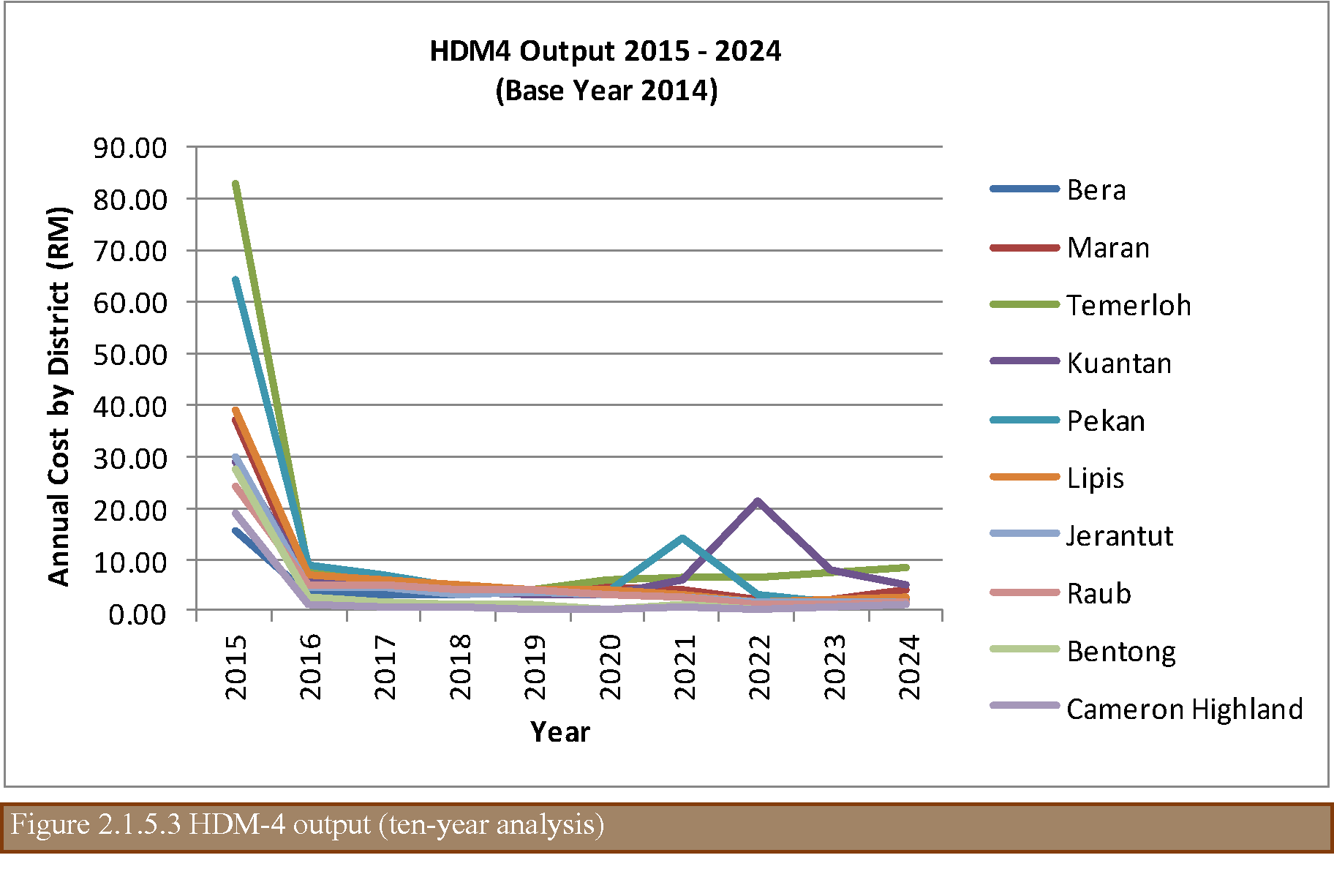
In conclusion, the proper and systematic collection of data using the correct and appropriate data collection equipment allows an adequate maintenance strategy to be applied.
CARLOS RUIZ TREVIZAN, National Highways Laboratory Department, Highway office, Chile
In recent years in Chile, activities have been intensified to improve traditional road maintenance management systems, innovating and diversifying the management systems of road conservation activities, incorporating road network systems, service levels, road concessions, execution and maintenance of basic roads (low cost roads) and maintenance by Direct Administration (using its own personnel and resources of the National Road Directorate of Chile).
One of the main axes to support this sustained growth in road management currently in Chile is the information provided by the Road Inventory and Visual Inspection of Paved Roads, which is done through automated equipment. This equipment with digital cameras, bars with lasers and bars with geophones are mounted on a vehicle which travels on the road at the same speed of flow and collects much of the information that is needed. IRI data can be obtained, cracking, road geometry, signaling, lighting, road safety, demarcation and shoulder data, among other parameters. The data is stored immediately and can be transferred to any database format required by the network administrator (see Figure 2.1.5.4).
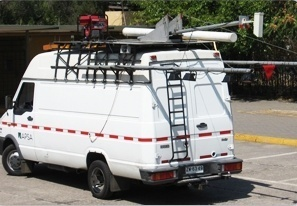
The captured and georeferenced digital images are entered into a program to identify the types of deterioration present in the roadway and a severity is assigned to then compute the deteriorated areas. The structural and functional deteriorations are then entered into the ICP indicator (Pavement Condition Index) to determine the qualitative and quantitative condition of the pavement. The ICP indicator corresponds to an own design of the Road Directorate of Chile and is the product of an extensive and complete study of behavior of the pavements, framed this in the implementation of a robust system of management of the pavements.
Another technology that has gone in breakthrough is the Georradar, which is a non-destructive technique that is based on the emission and propagation of electromagnetic waves in a medium, with the subsequent reception of the reflections that occur in their discontinuities. The application in a first stage of 5,500 kilometers of pavements, complemented with the extraction of witnesses of pavements and exploration shafts on the side of the roads, allowed to update and correct a large part of the road inventory of paved roads in terms of characteristics and types of materials that make up the road surface.
Currently in Chile, and after several periods performing the visual inspections of pavements by manual means and with personnel from the National Road Directorate itself, it has been decided for 4 consecutive periods to carry out a large percentage of this task through consulting contracts and with automated means. In 2017 they were tendered in the National Roads Authority of Chile 13,404 kilometers of automated auscultation of about 14,834 total kilometers evaluable, representing 90.4%. This growth in the automated visual inspection of pavements carried out in Chile can be seen in Figure 2.1.5.5.
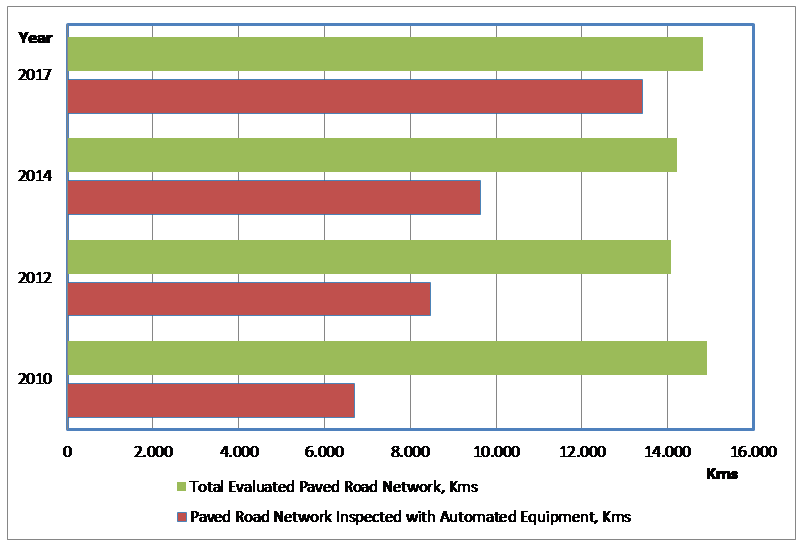
With the results of this automated visual inspection, a large amount of parameter information is obtained from the paved network, which allows the execution of the HDM-4 software to develop periodic maintenance projects that maximize social benefits and provide a greater social return of investment in the country's road infrastructure. These projects are proposed to each of the 16 Regional Road Directions in which the country is administratively divided to be considered in the prioritization of the works that will be executed in the short term and in the relevant budgetary processes. In addition, the automated visual inspection allows tracking the status of the paved road network of the country so that the community and the authorities of the country have a global knowledge of its evolution as shown in the following Figure 2.1.5.6:
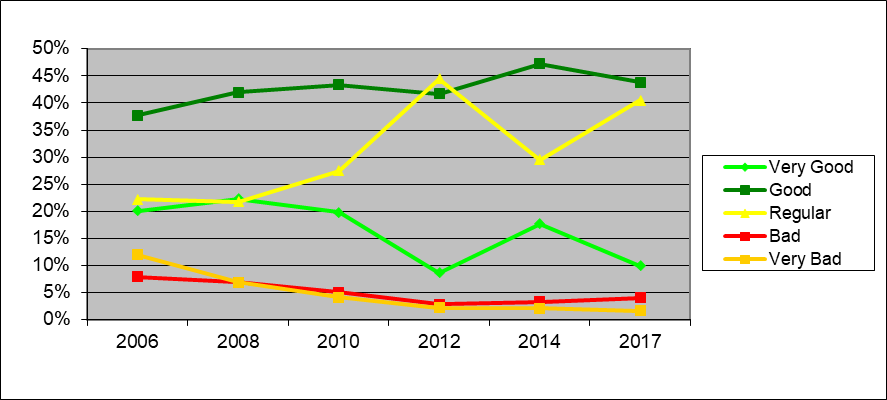
This summarizes the activities and results obtained from the process described above, which is currently carried out in Chile to manage the entire paved network under the responsibility of the National Roads Department. More information on this can be found on the website of the Roads Department of Chile according to the link: http://www.vialidad.cl/areasdevialidad/gestionvial/Paginas/Informesyestudios.aspx
BEN HELSEN, Flemish Roads and Traffic Agency (AWV) - EMT, Belgium
The IIR (Inventory, Inspection and Reporting) project was started within the Flemish roads and traffic agency (AWV) in 2012, with a view to achieving efficient inventorying and inspection of road accessories (both electrical equipment and the actual road accessories, as well as road condition).As part of the group of electromechanical facilities, sign gantries for dynamic traffic management (DTM) were included in the project from the start, mainly on account of their potential risk (position above the carriageway).
The electromechanics and telematics (EMT) division of AWV – more specifically its traffic enforcement systems (VHS) team, which also provides the operational management of those facilities – was placed in charge. The objective of AWV is to take a detailed inventory of the full asset in place. Newly installed facilities (e.g. in new construction projects) are added to the inventory as standard procedure.
The inspections include assessing and recording the condition of the facility, with special focus on stability, corrosion and the condition not only of the columns, but also of the clamps and bolts.
The approach is a basic solution to manage the maintenance risk of electromechanical facilities, sign gantries for dynamic traffic management (DTM) on the Flemish roads.
Efficient inventorying and inspection of road accessories. The objective of AWV is to take a detailed inventory of the full asset in place.
The inspections include assessing and recording the condition of the facility, with special focus on stability, corrosion and the condition not only of the columns, but also of the clamps and bolts.
Structured detailed inventory of the asset (of DTM sign gantries in this case), with a representative inspected status of both the entire facilities and their relevant parts. Using this inventory, status reporting makes it possible not only to define an adequate maintenance policy but also to take targeted remedial (or, if necessary, proactive) measures through the maintenance programme – which is otherwise mainly directed to operationality – or, if necessary, through well-advised targeted (re-)investments.
Before the IIR project, AbbaMelda was already a first form of asset management, at least as far as the electromechanical facilities managed by AWV’s EMT division were concerned. However, it was a rather single level and little structured listing of facilities mainly intended for use in calling up the contractors concerned in case of defects or damage and in recording the calls and their handling. Moreover, the listing was high-level as far as the facilities were concerned, with little on no specification of component parts and, consequenly, few or no interrelations.
A safety incident triggered the setting up of the IIR project, which built on the existing AbbaMelda data base for electromechanical facilities such as DTM sign gantries.
The facilities already included were renamed in many cases, but also – and mainly - often merged into coherent logical sets. Many more component parts were specified and included (e.g., not only the sign gantry with variable message signs, but also the individual signs, their controller cabinet and the representative parts inside, and characteristics of, that cabinet. Electric power supply and the communication network were included as well.
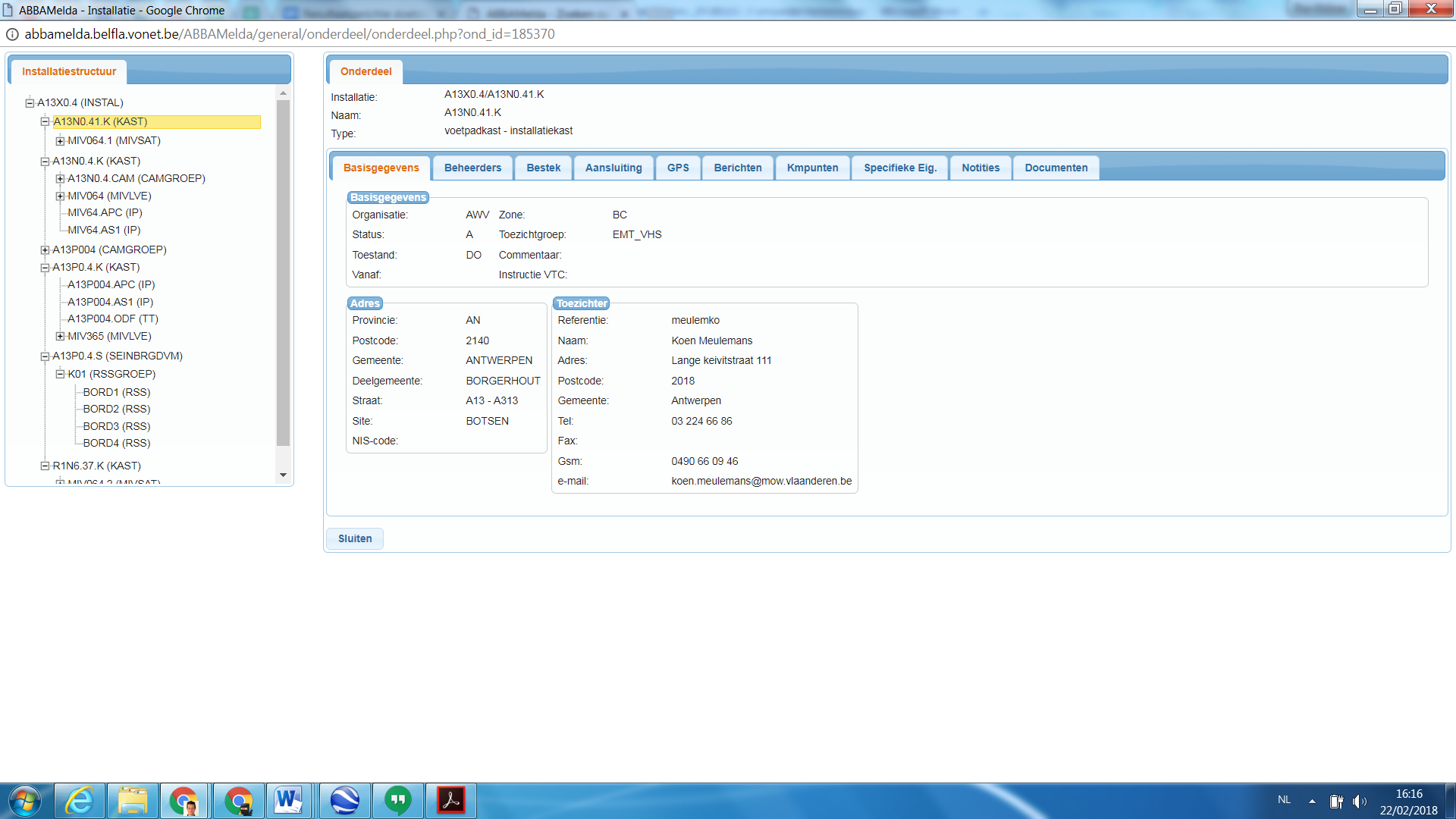
Additionally, maximum accuracy (typically GPS) location data were assigned to the facilities and parts, enabling the data to be coupled in numerous GIS applications for various purposes (e.g., conflict detection in case of scheduled works).
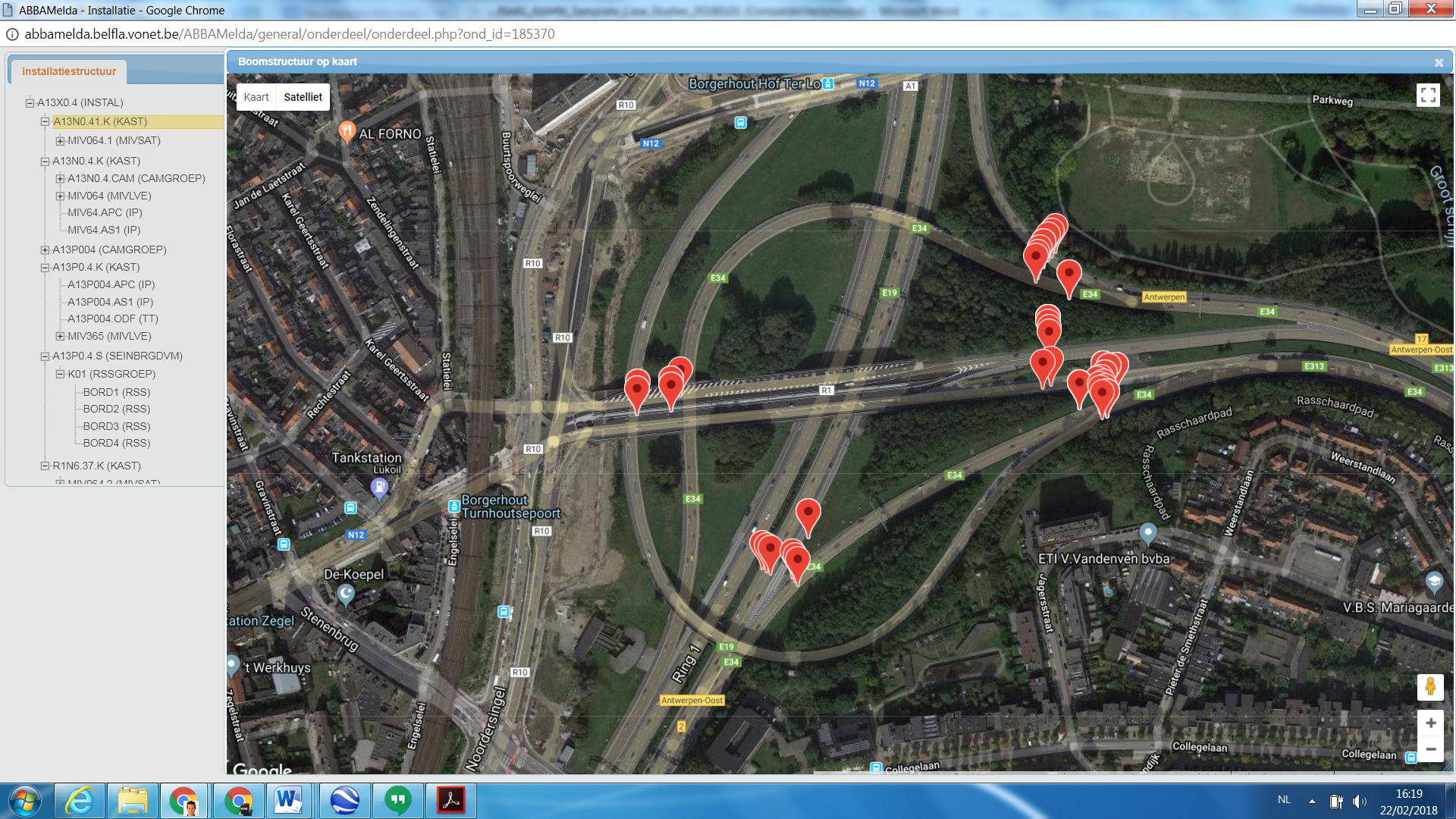
Figure 2.1.5.8: AbbaMelda data base for electromechanical facilities
A portal named “Mobiel” was developed for use on a tablet, which made it possible not only to inventory (or continue inventorying) facilities on site, but also, and mainly, to inspect them.
A few screenshots for DTM sign gantries are presented below.
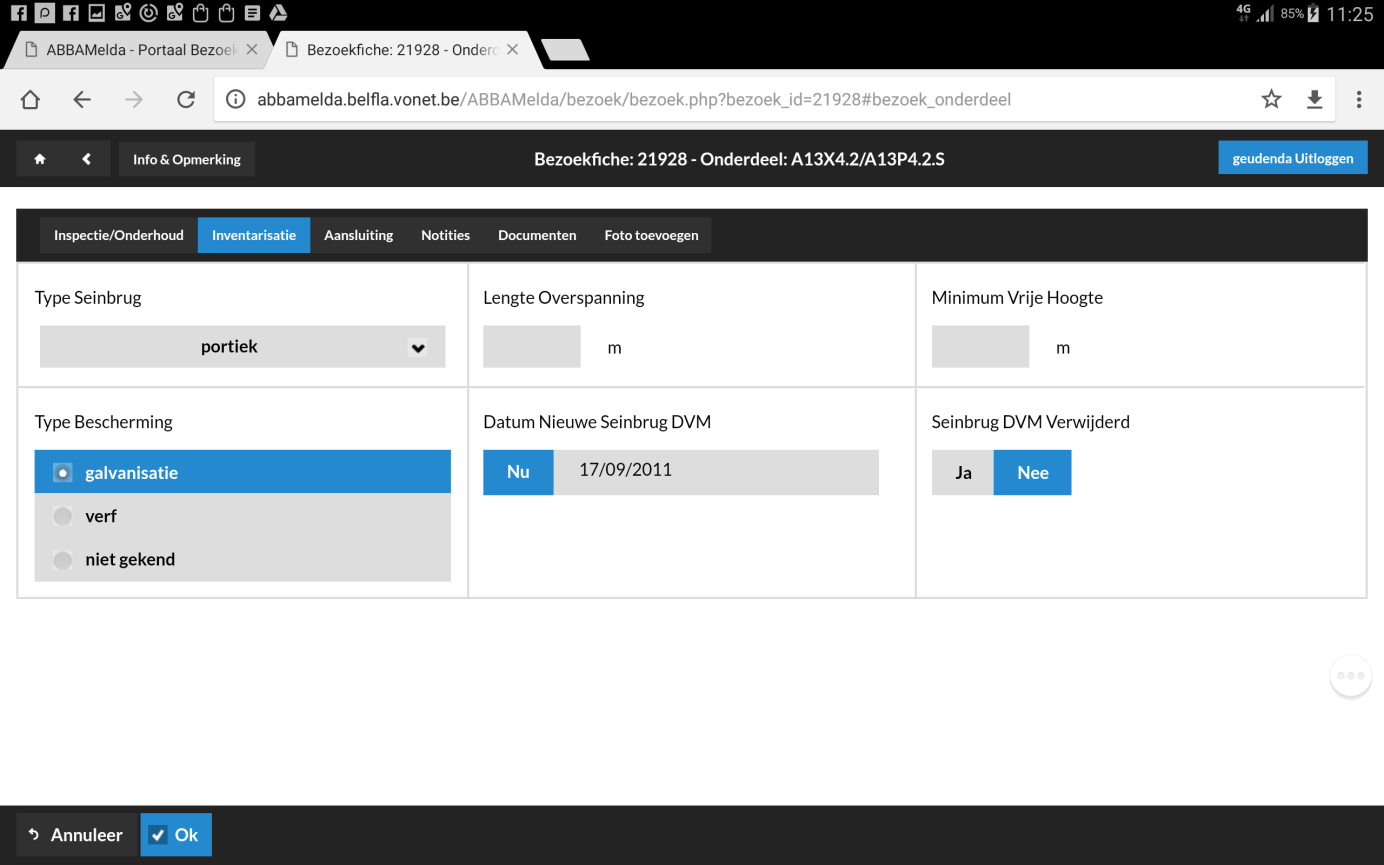
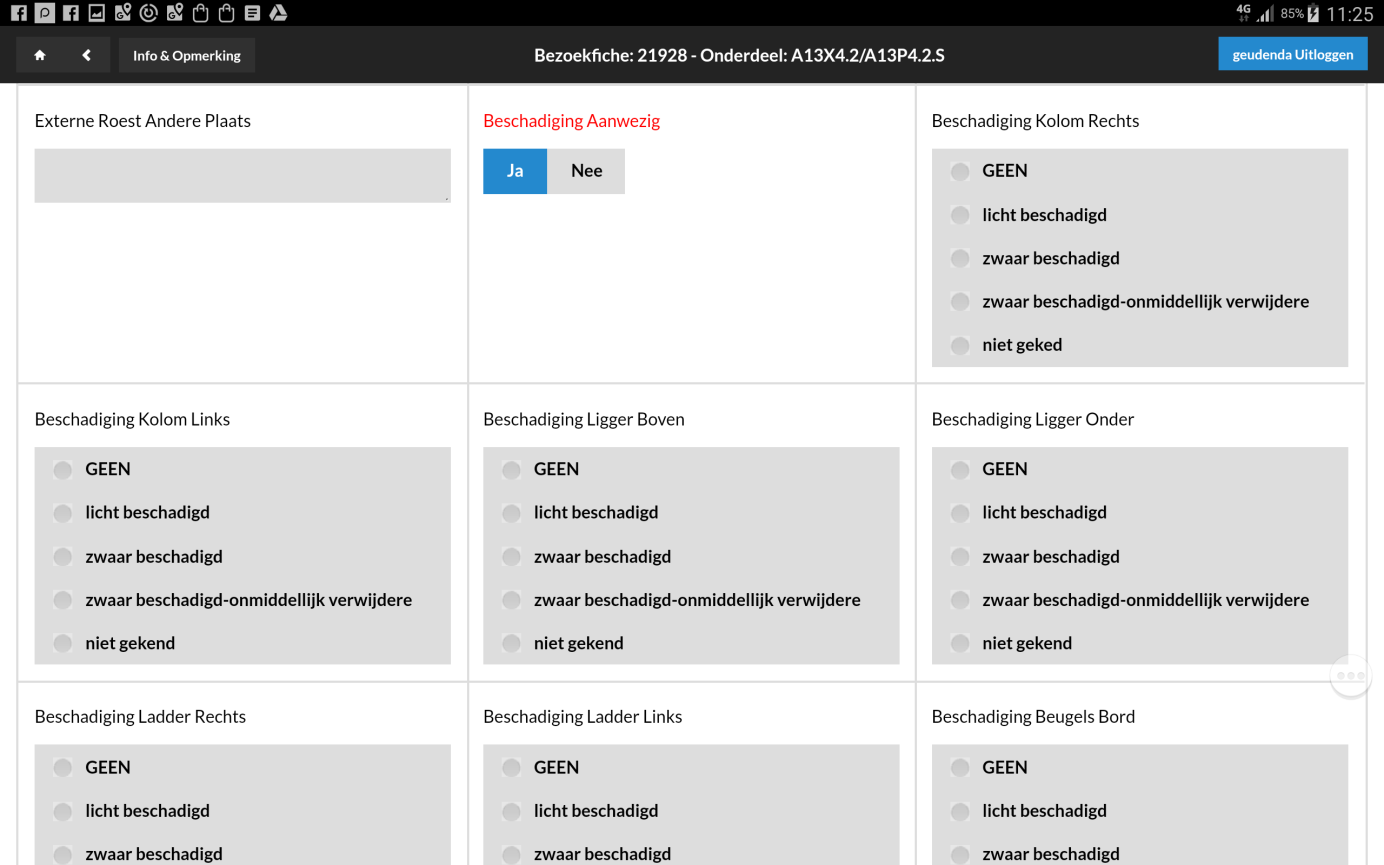
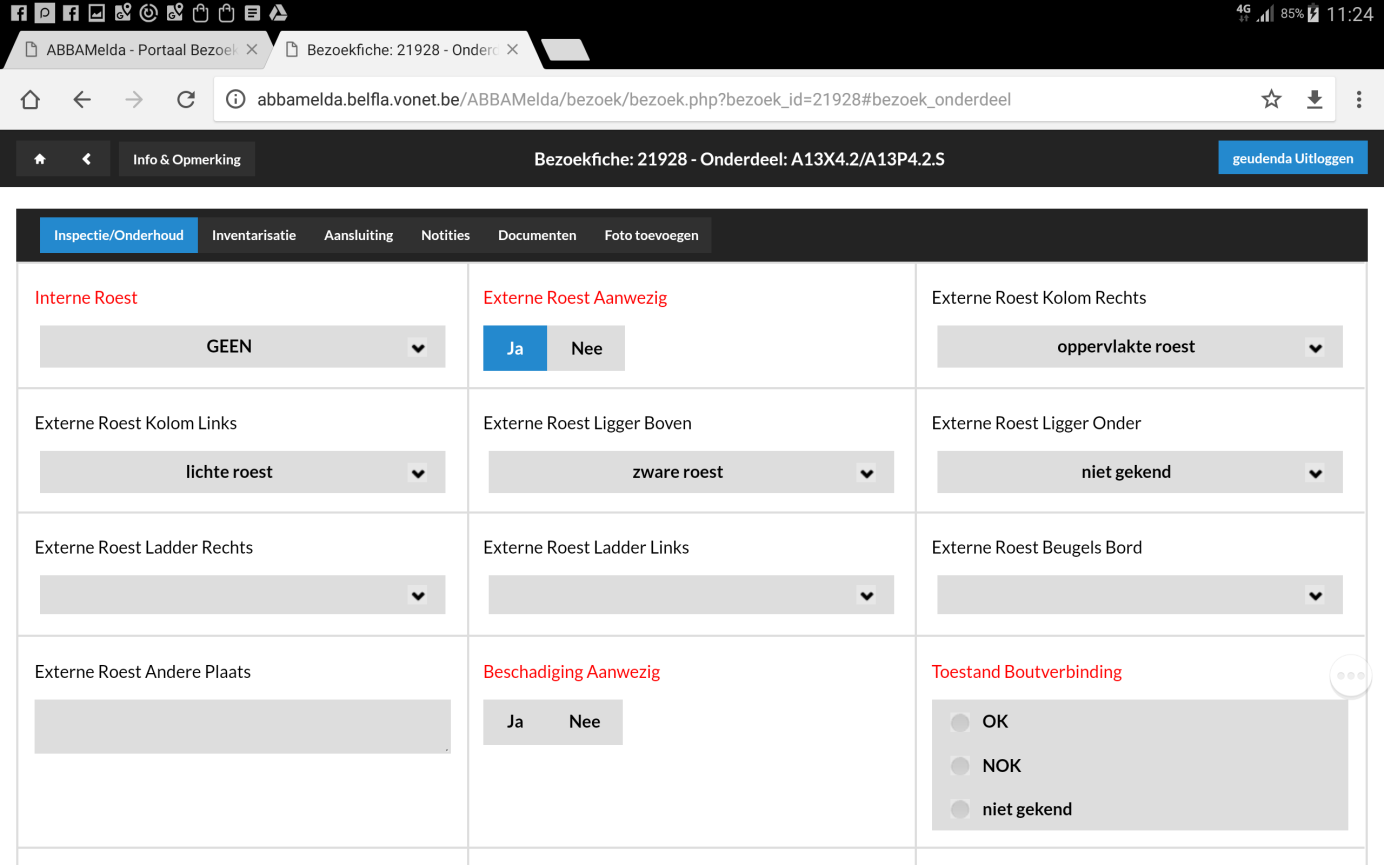
Two new projects were recently started. In the first project, the existing application AbbaMelda is divided into two parts, with the facility database part being renewed into a modern application which not only better suits the functional needs but wil also, and mainly, provide additional possibilities for interrelations, structures, etc. Concurrently, an AIM/BIM-oriented project was launched at AWV level.
Whereas a few years ago AbbaMelda was mainly a tool for recording and monitoring defect repairs, it has developed and is still developing further into a central data base of electromechanical facilities managed by AWV: type of facility, location, interrelations, status, parts, persons in charge, etc.